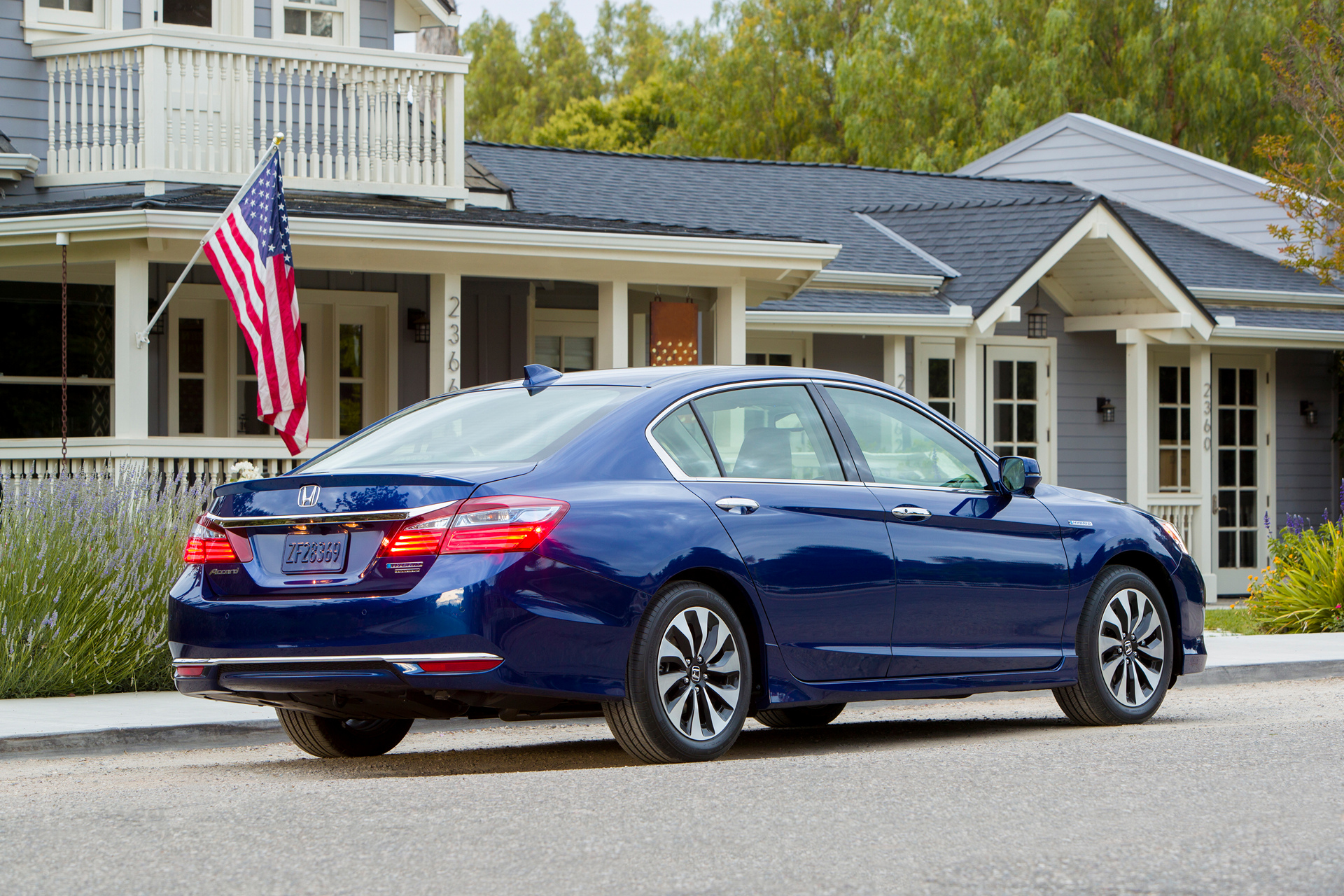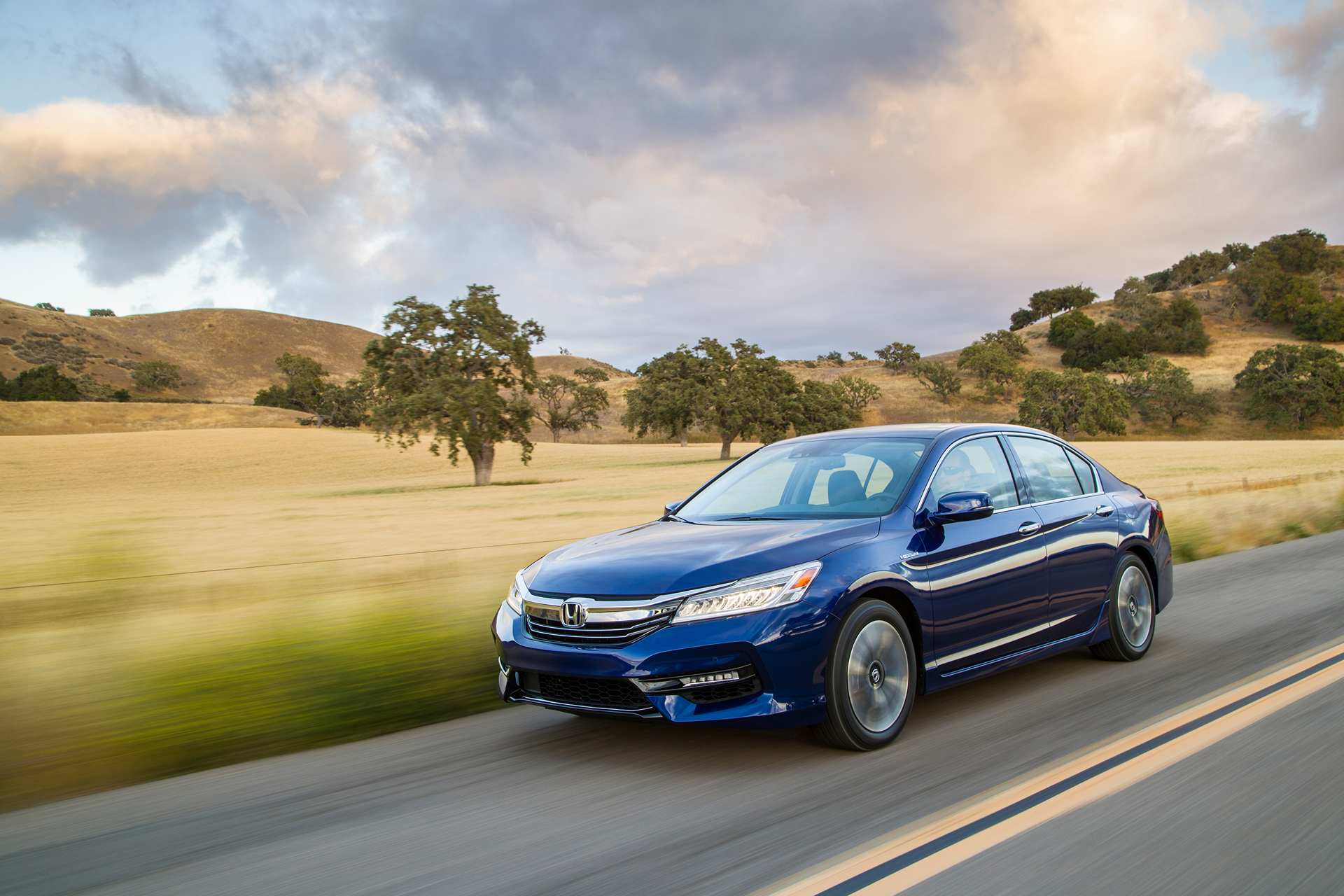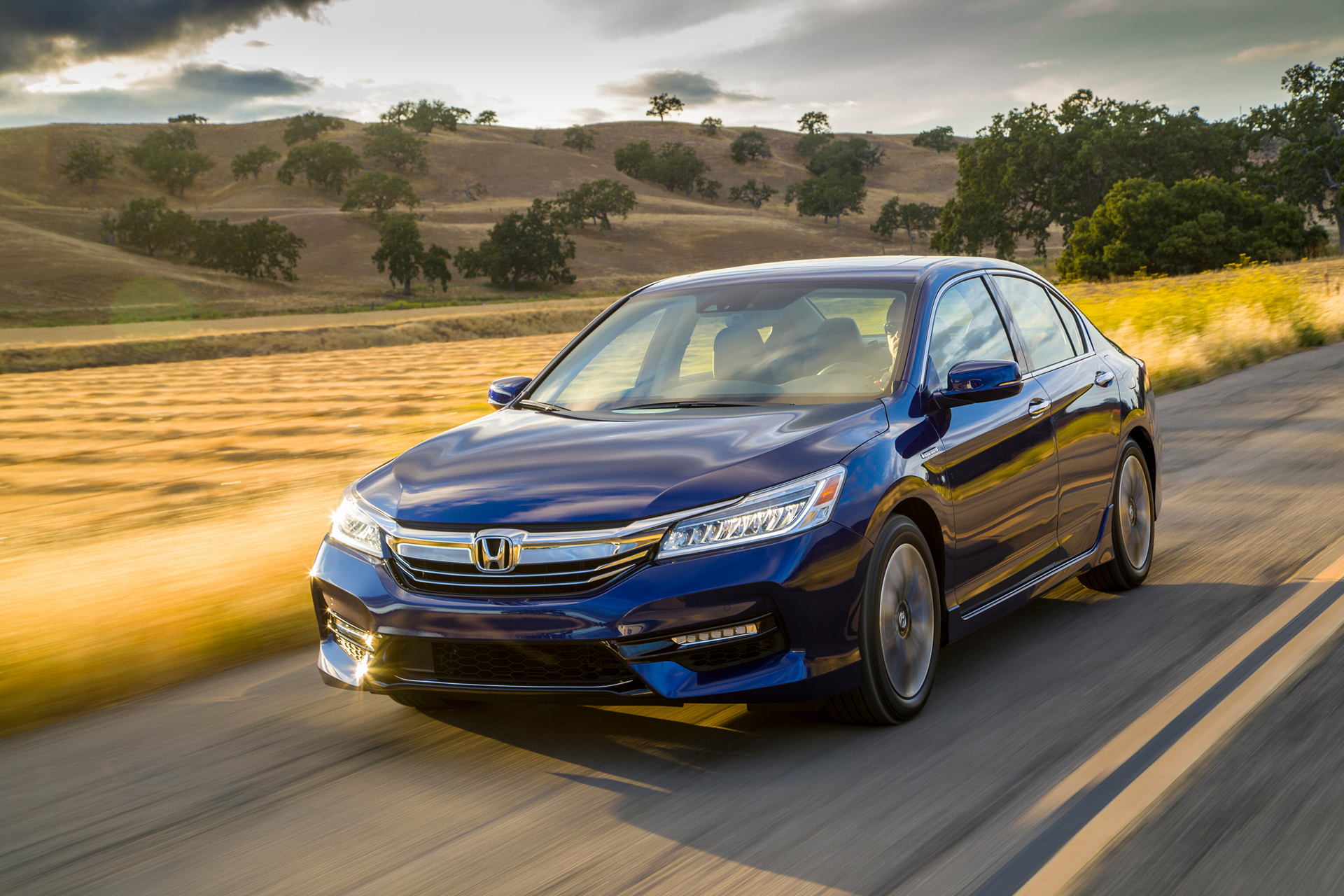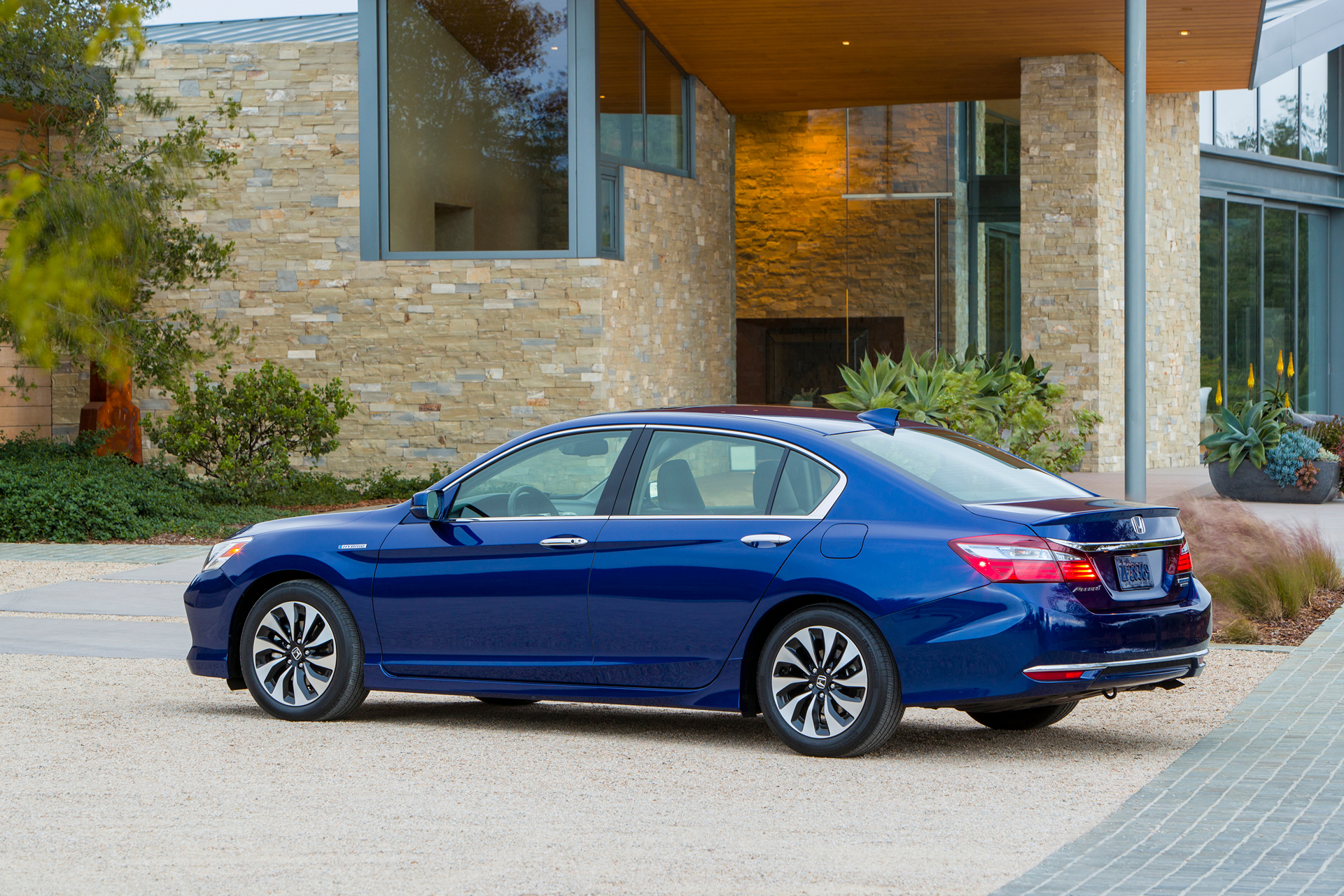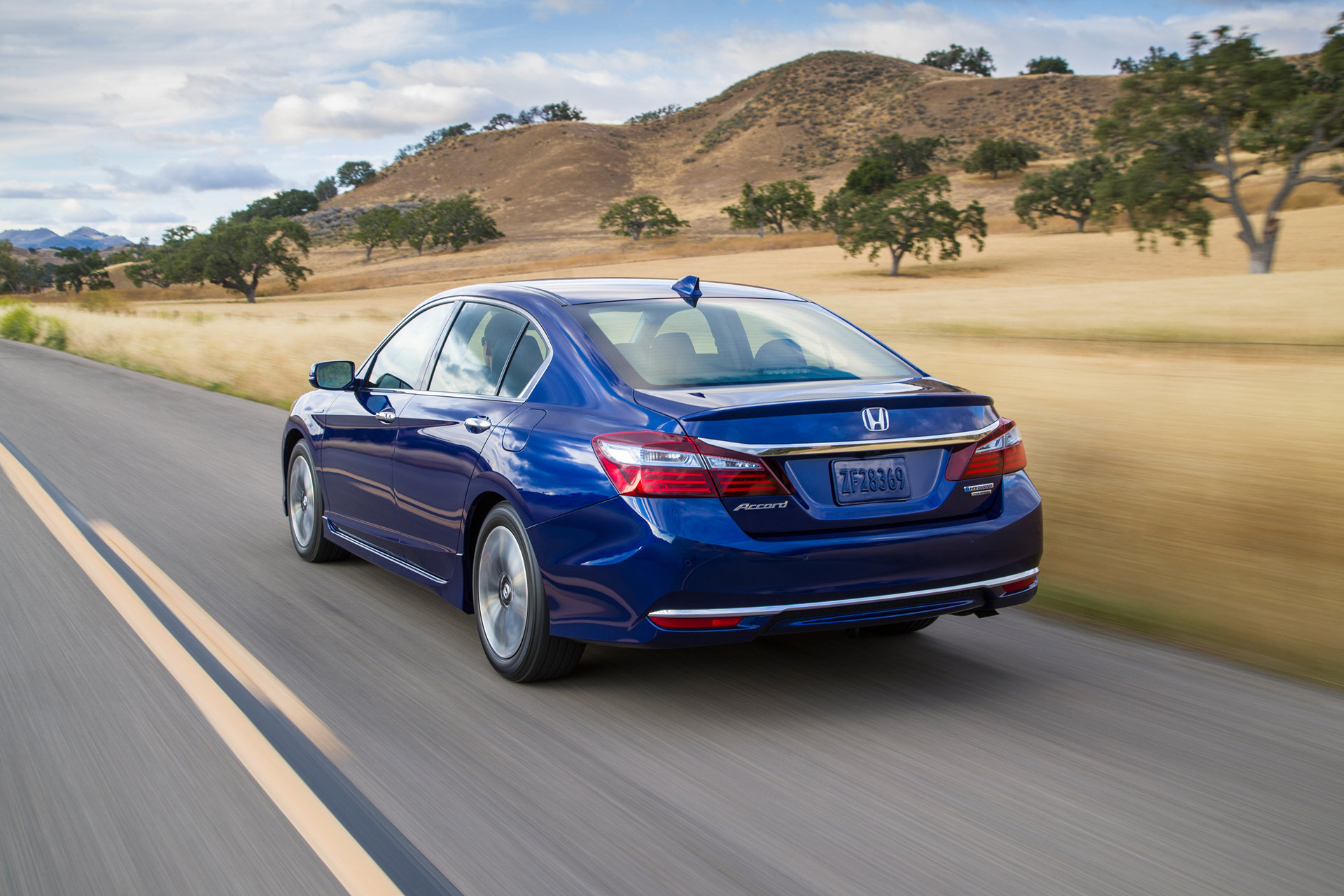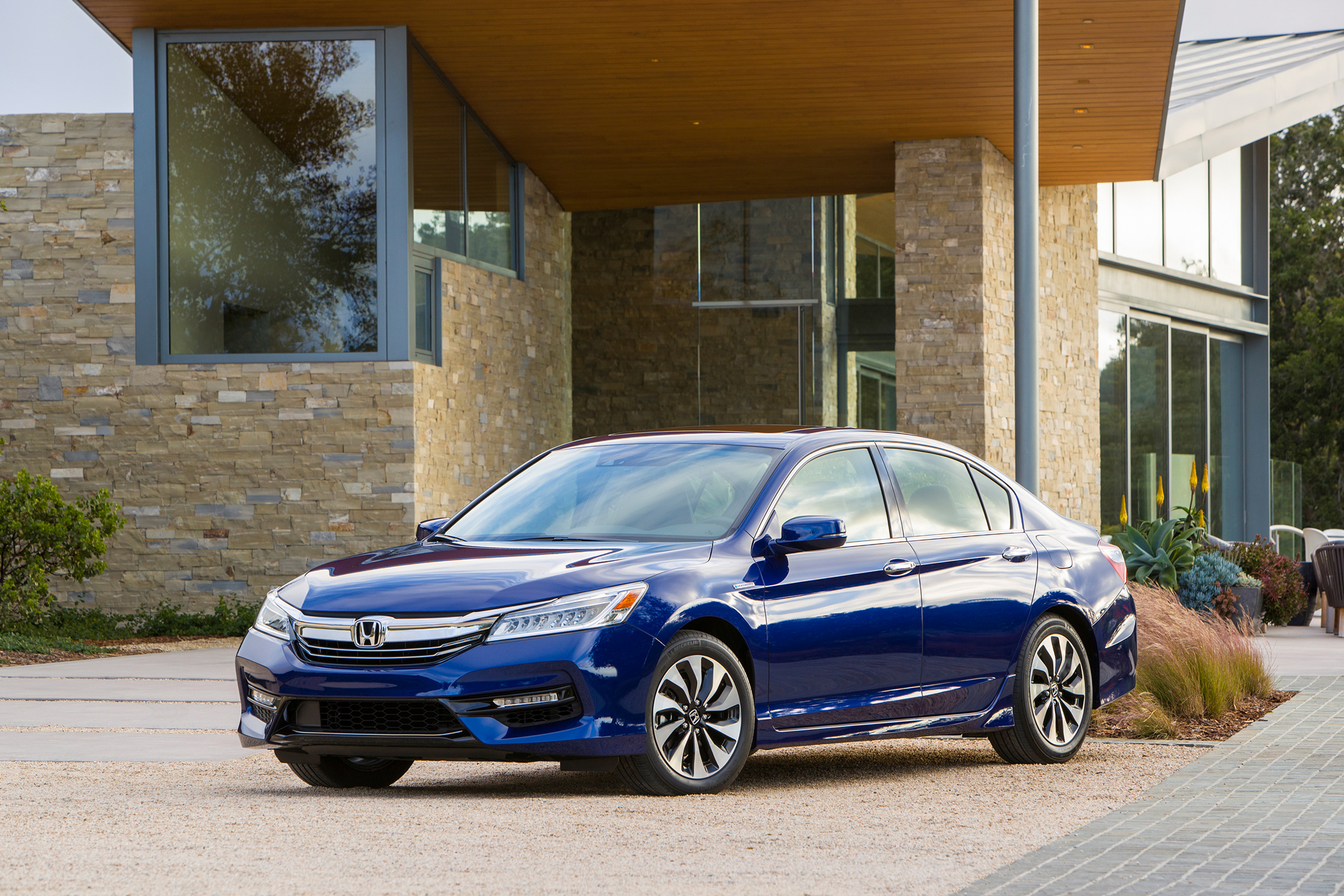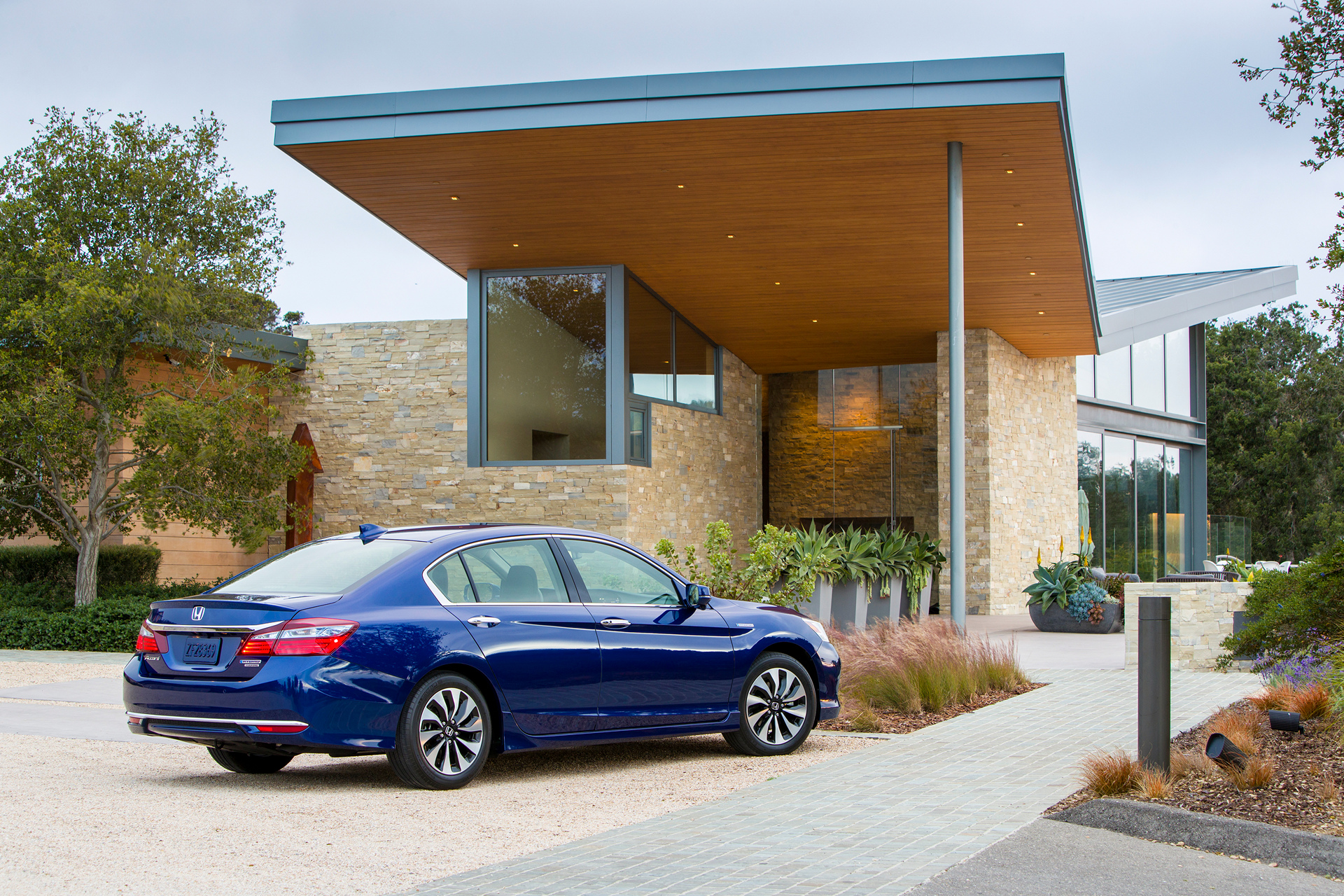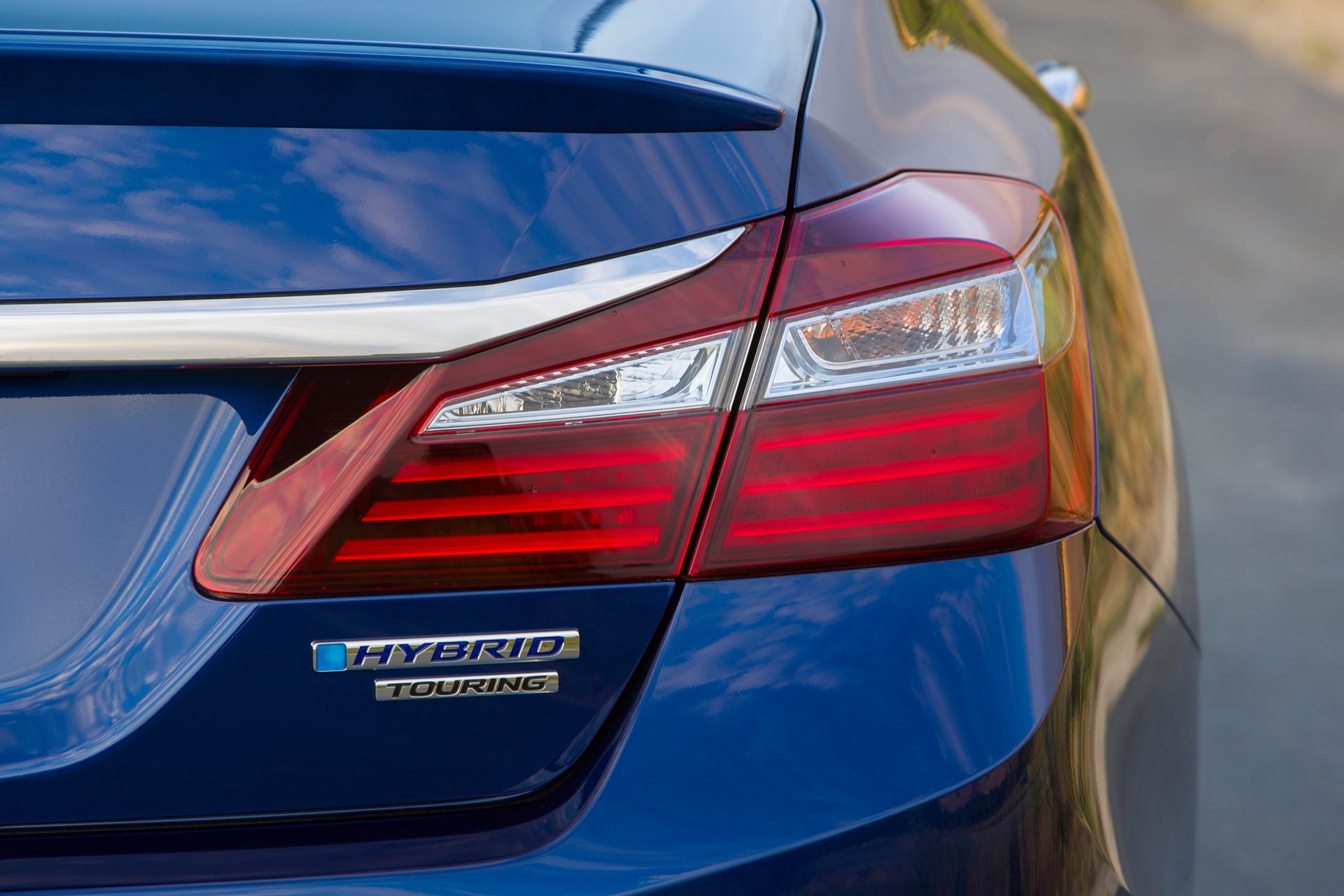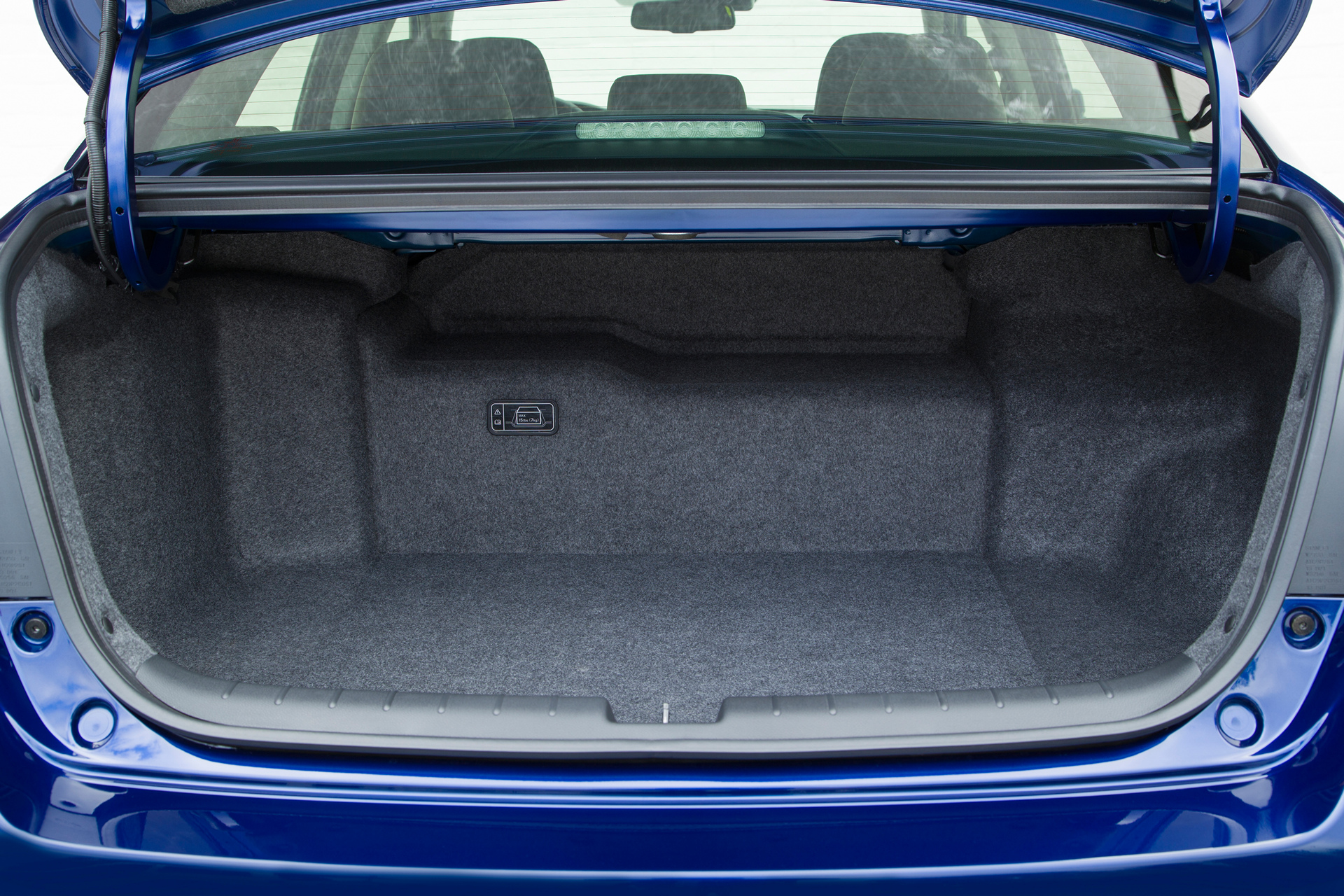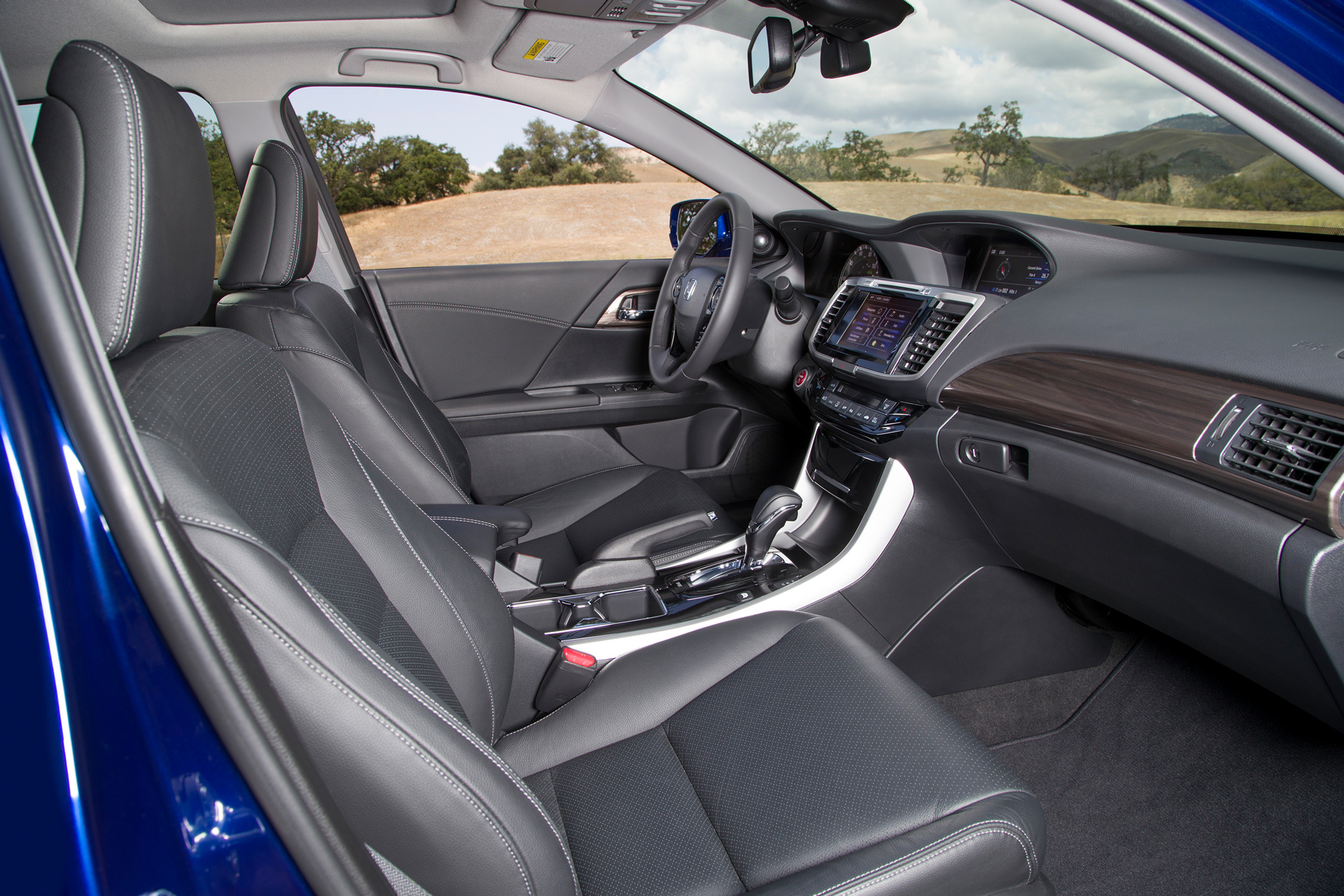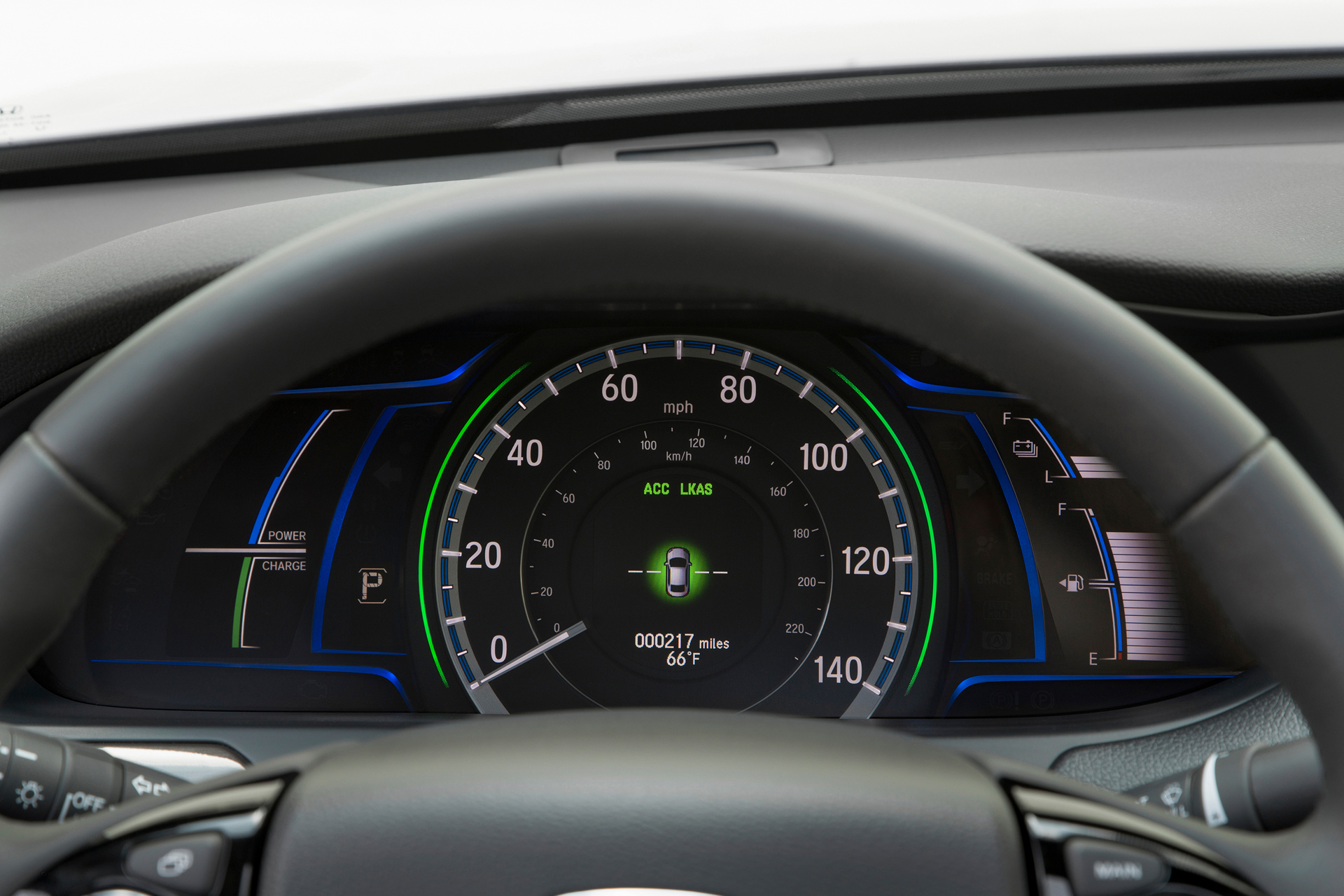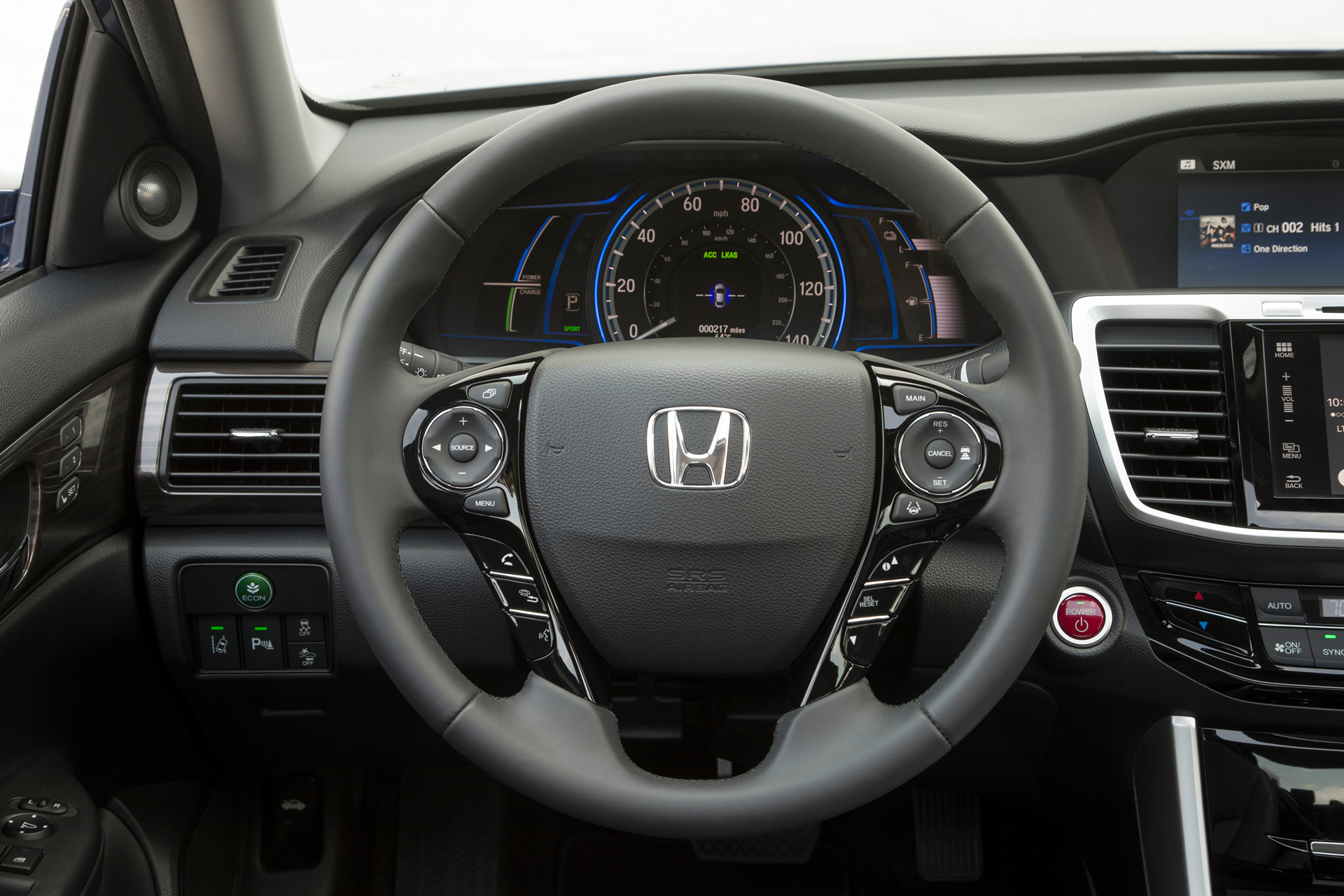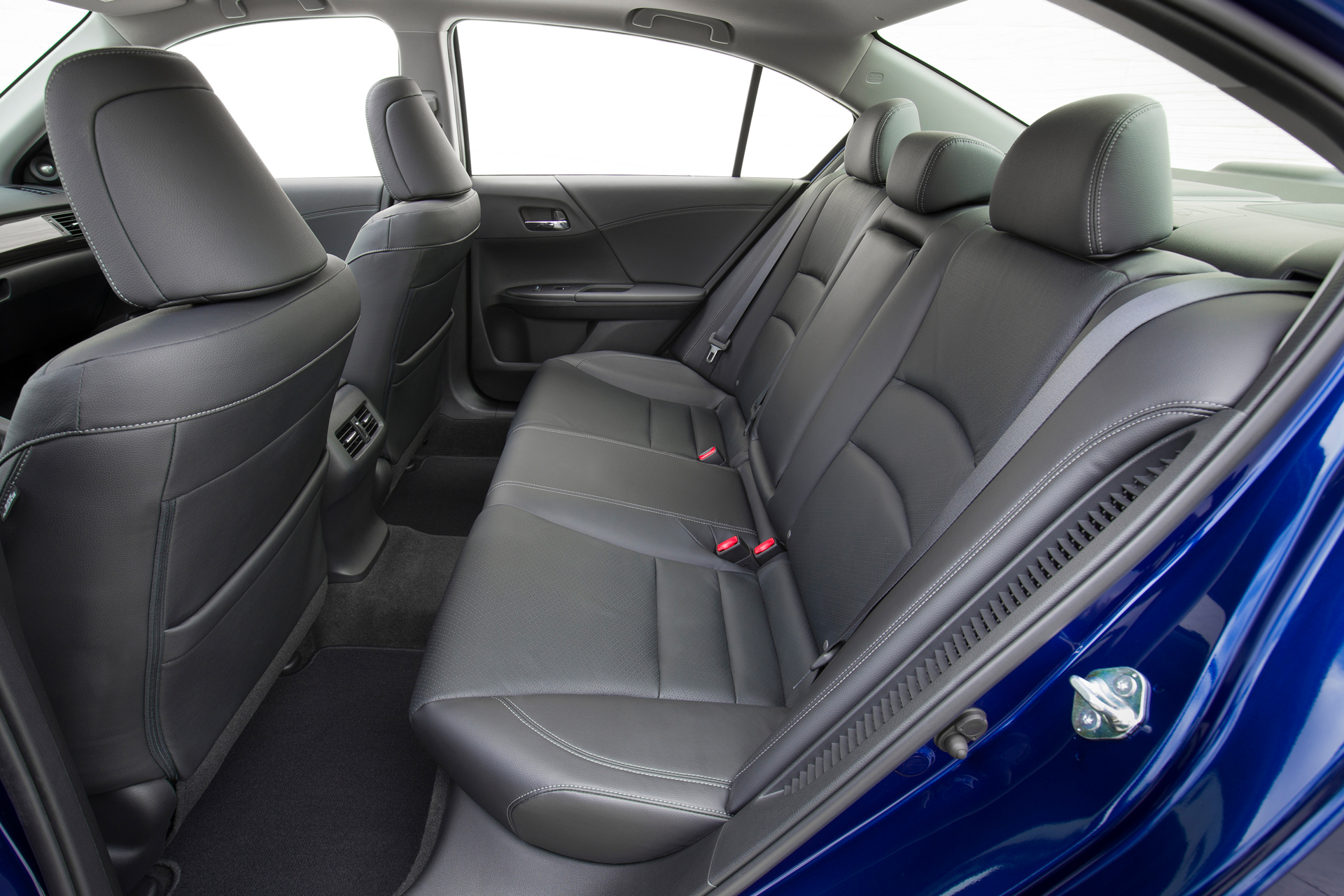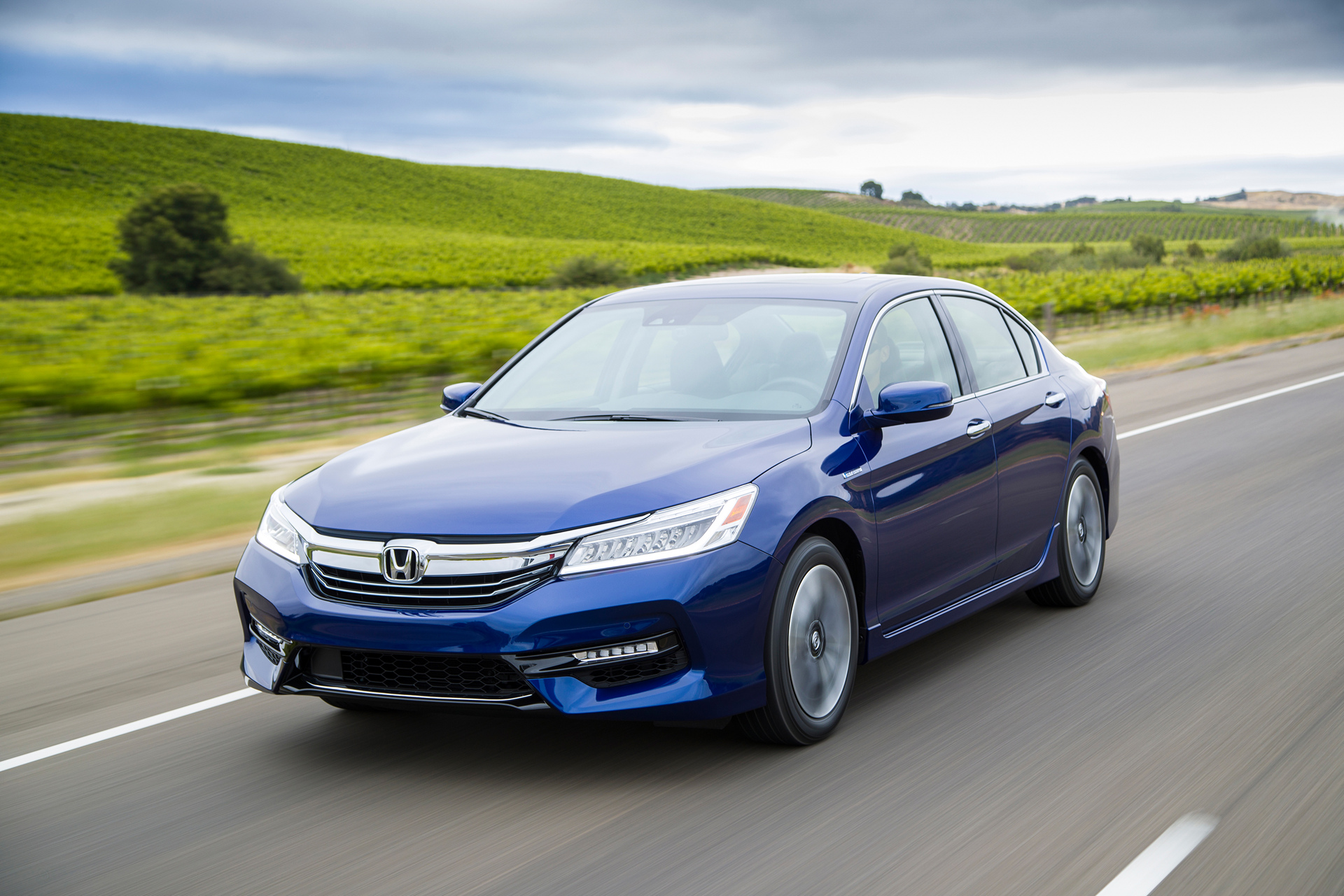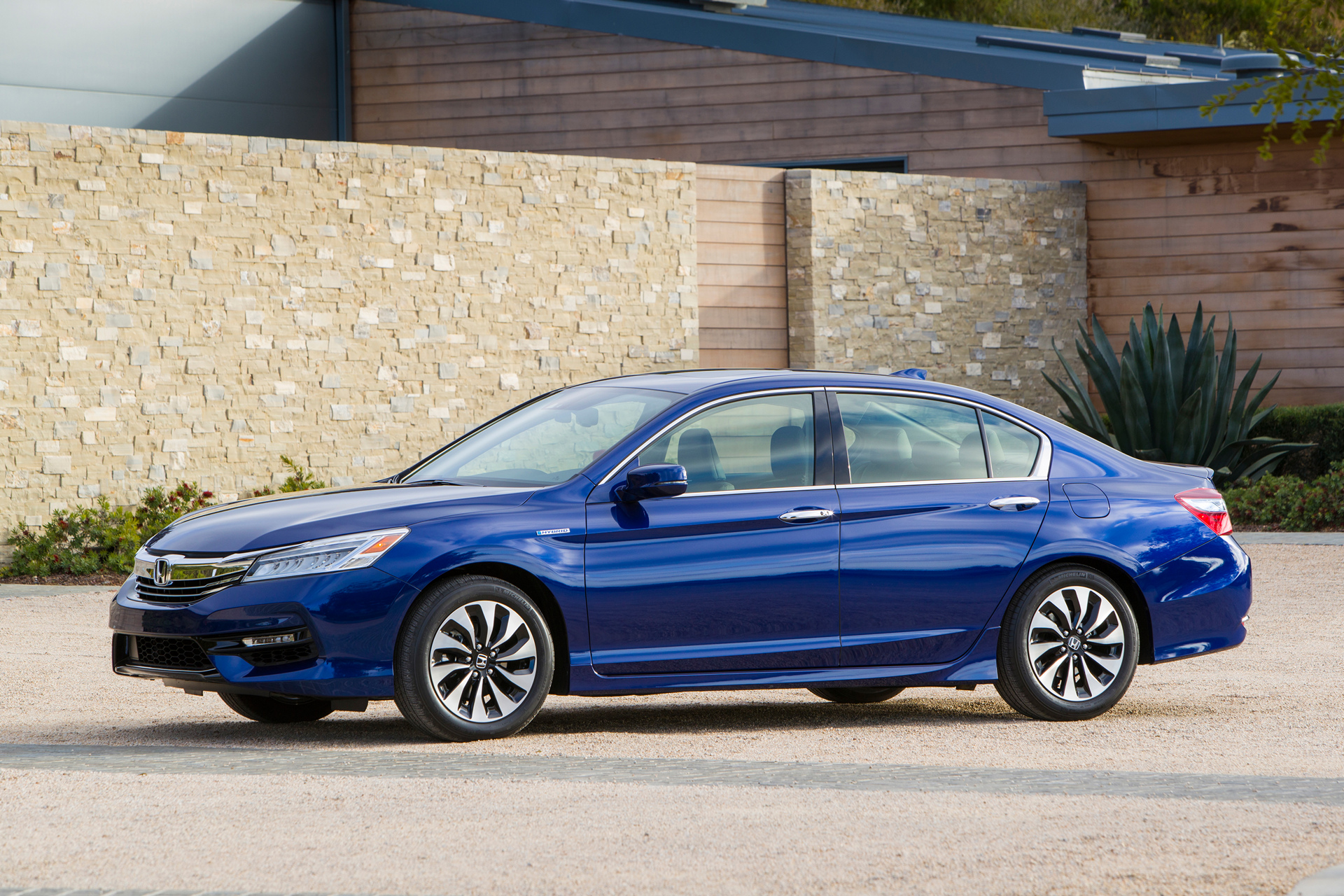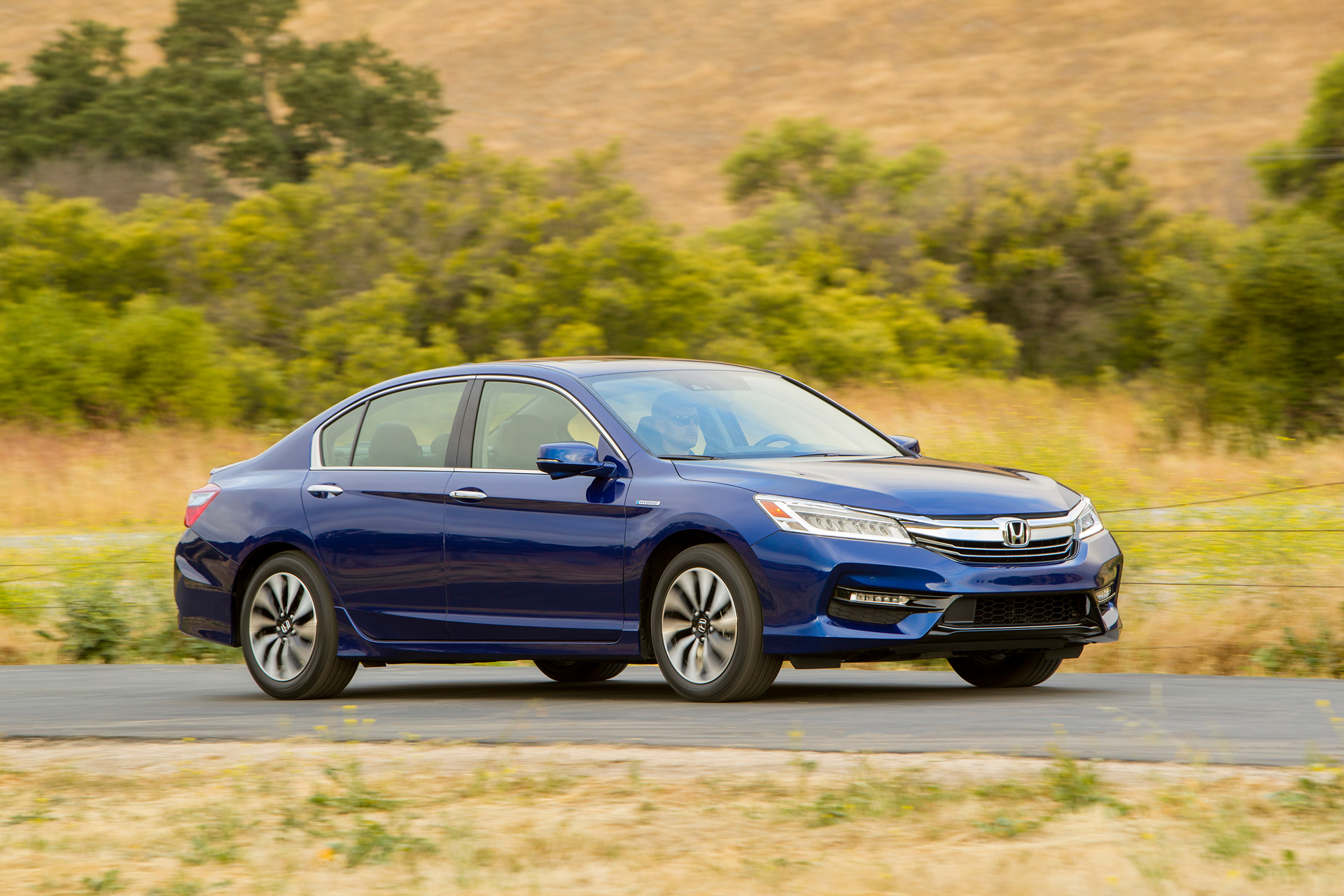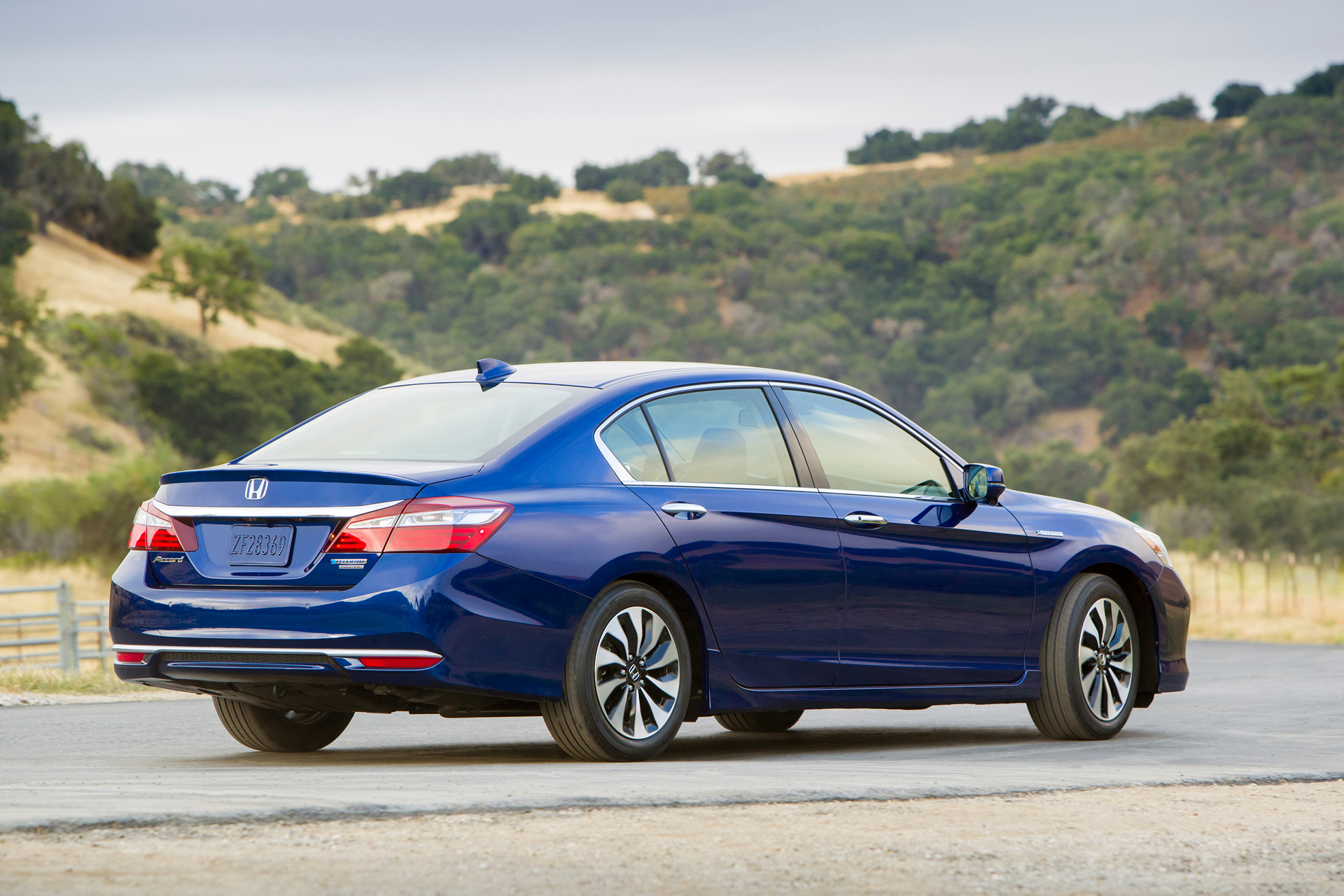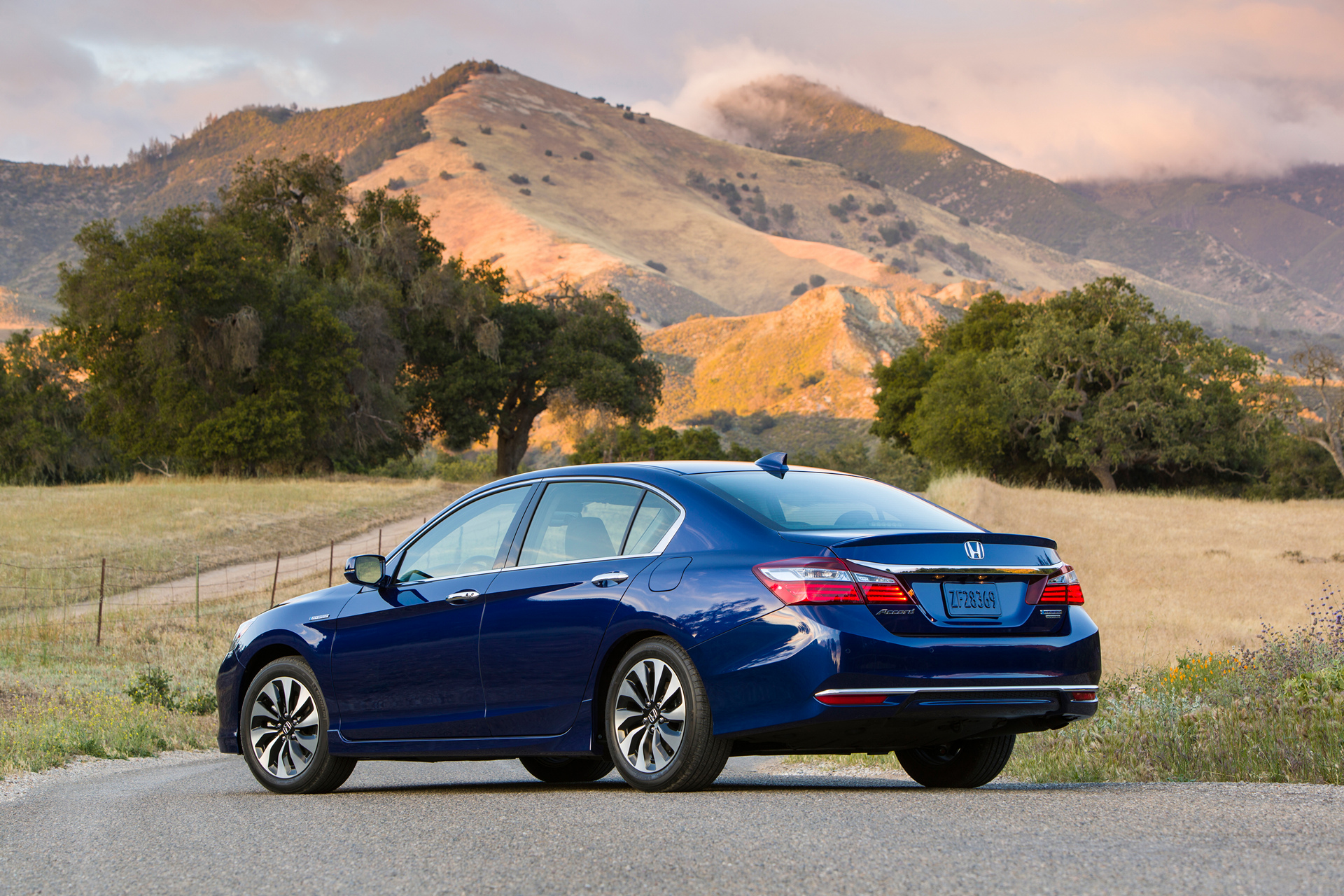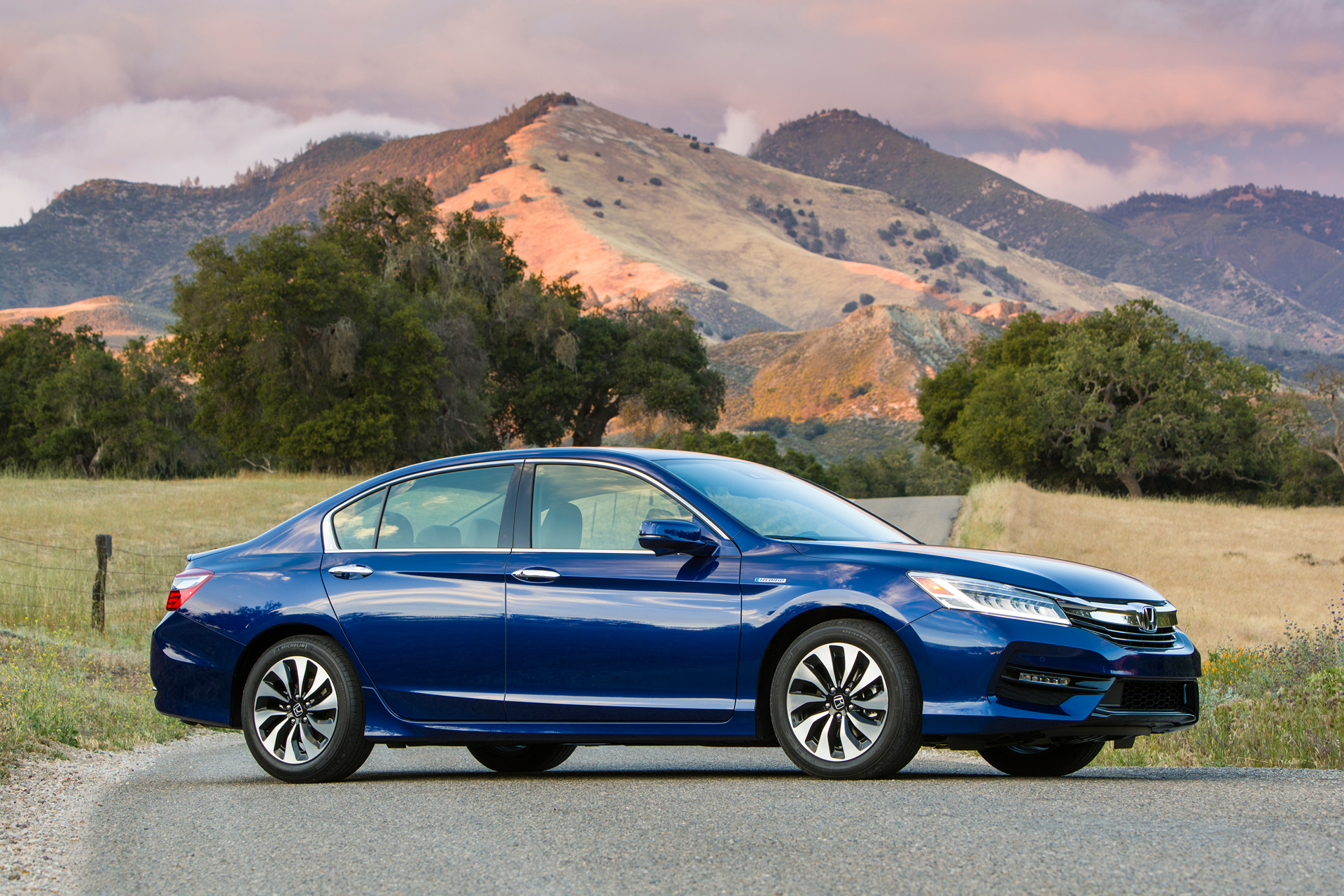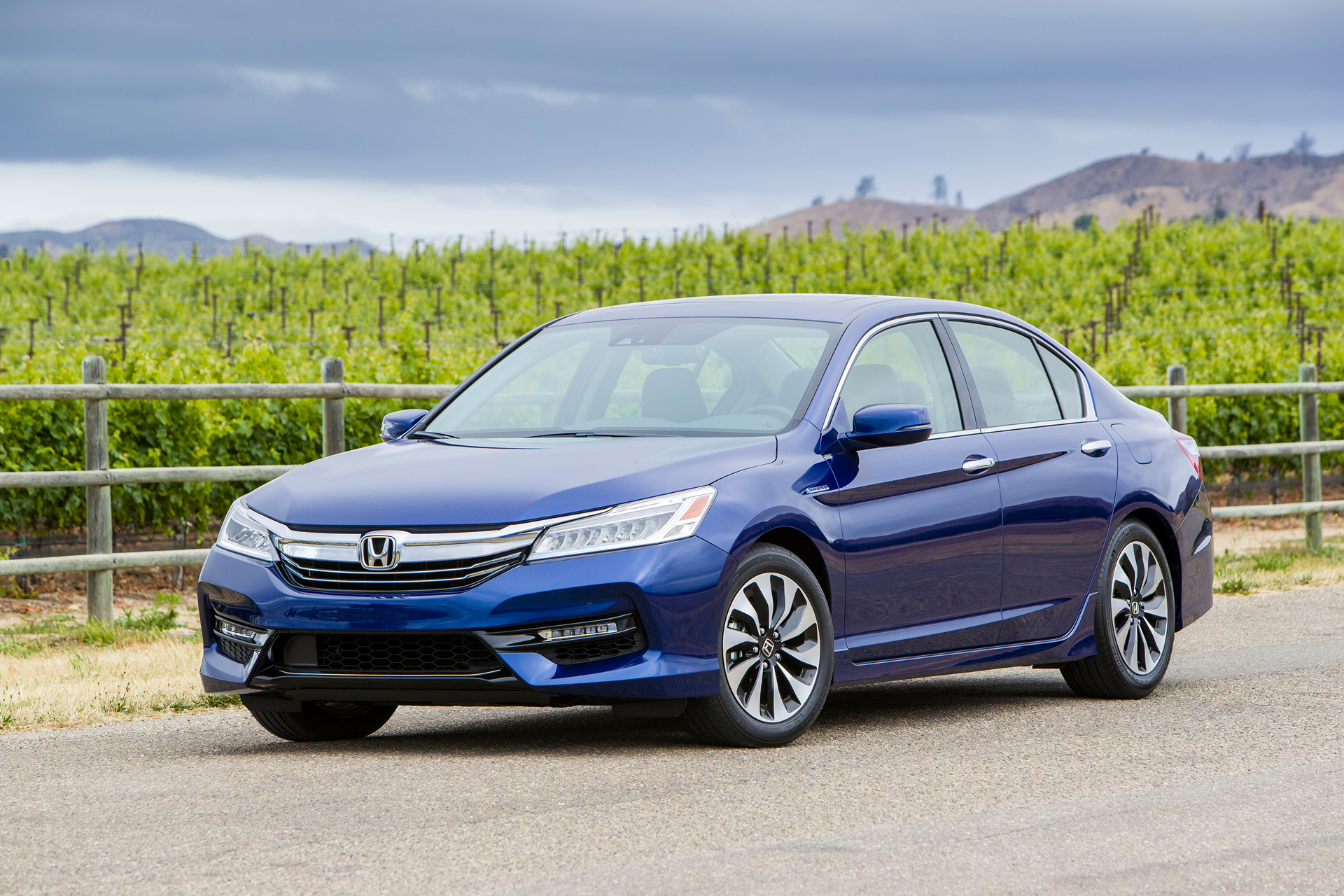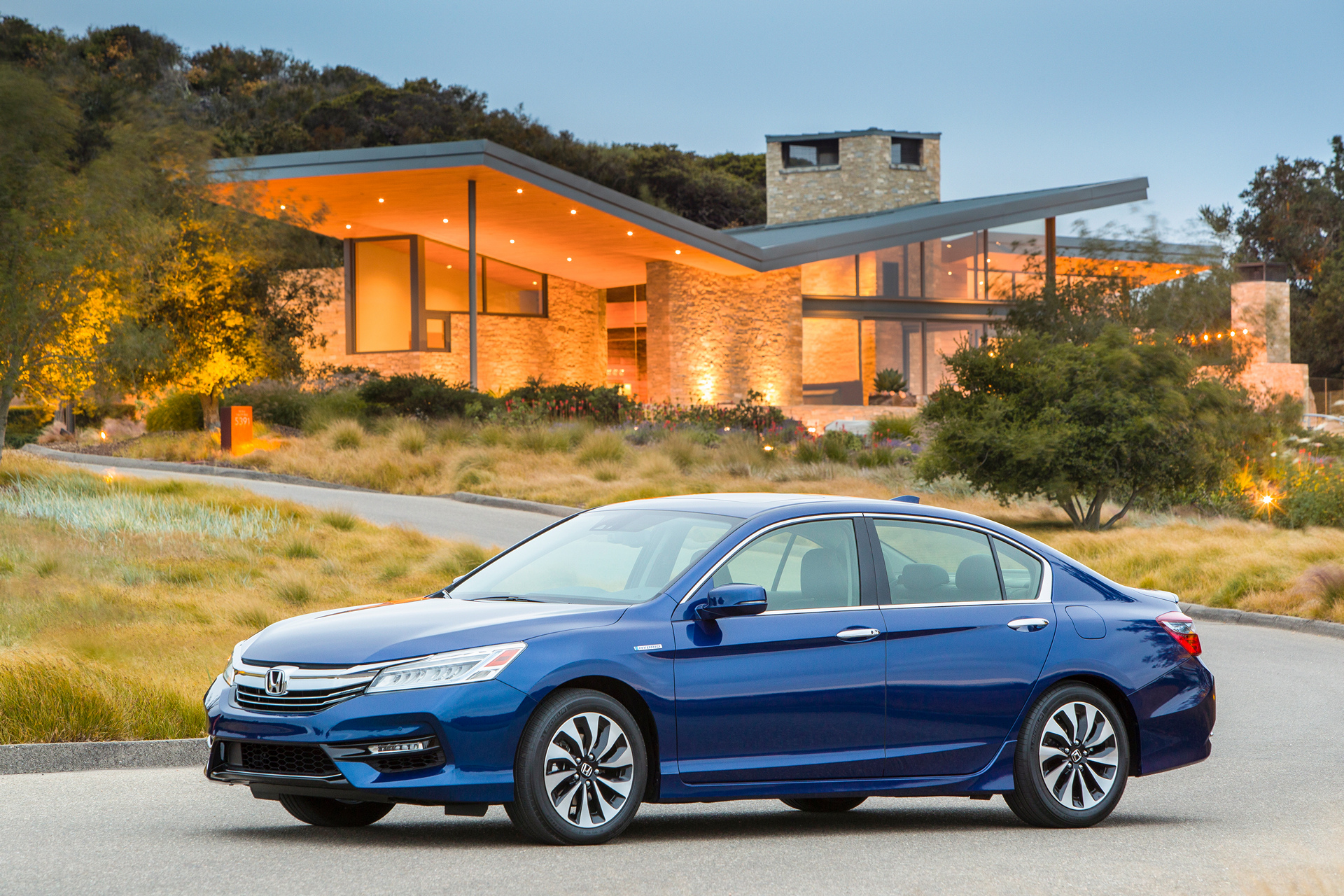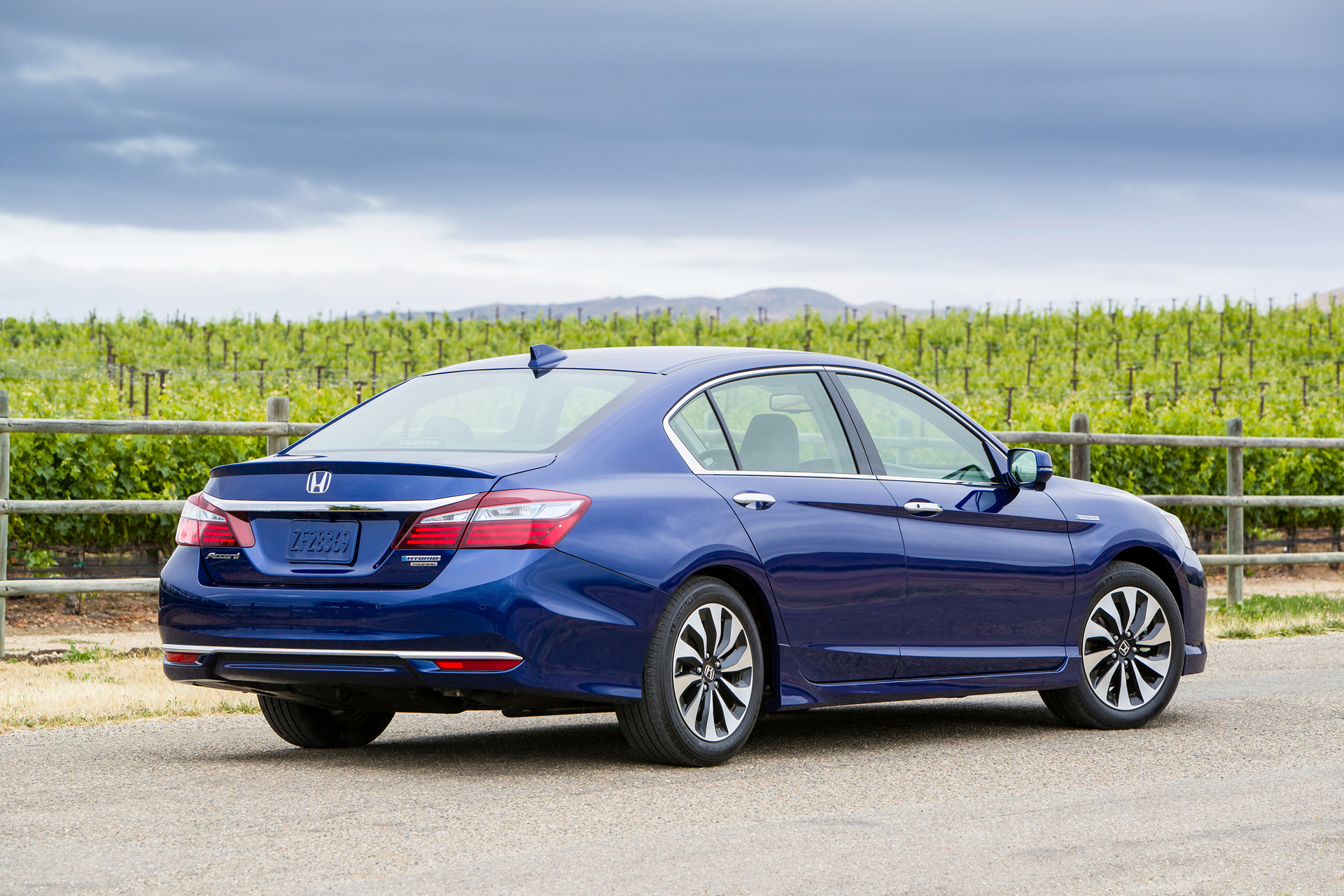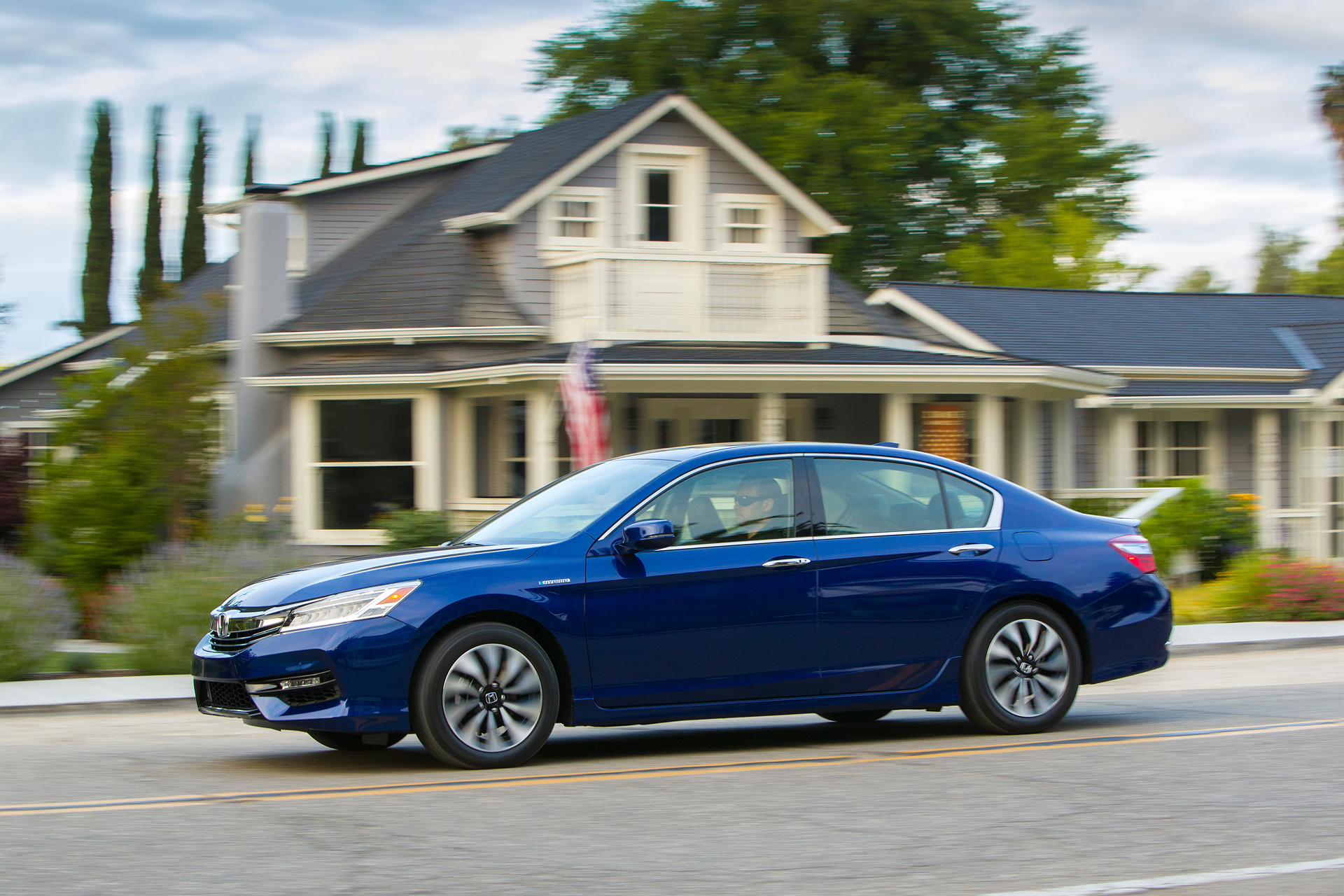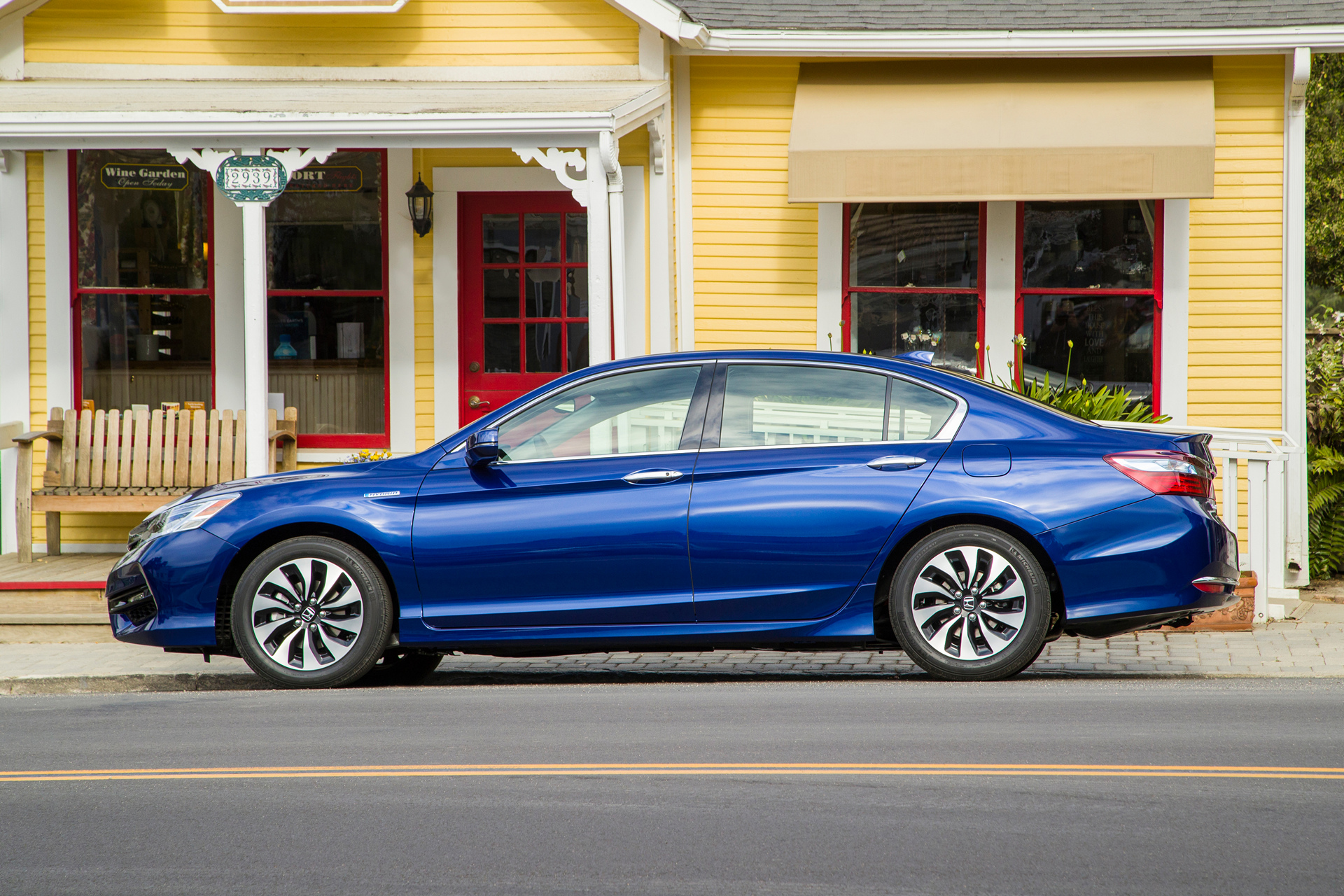With its innovative and elegant two-motor hybrid powertrain, the 2014-2015 Accord Hybrid set the benchmark for a mid-size hybrid sedan in refinement, advanced technology and class-leading fuel efficiency.
The 2017 Accord Hybrid moves even further ahead of its competitors with the application of a second-generation two-motor hybrid system, providing even greater fuel efficiency and class leading total system horsepower while benefitting from the styling and technological enhancements made to the Accord lineup for model year 2016. From an Accord family perspective, the new Honda Accord Hybrid is the ultimate Accord, the most refined, technologically sophisticated and, of course, most fuel efficient model in the lineup.
Celebrating its 40th anniversary this year, the Accord has set the benchmark for vehicles in the midsize sedan class. Accord is widely recognized as a segment-defining product, delivering class-leading interior space and superior ergonomics along with outstanding fuel efficiency, refined and responsive driving dynamics and top-class safety performance. This is what has made the Accord America’s most popular car for five of the past six years and for the last three years running, and the best-selling midsize car to buyers under 35 years old for the past four years1.
The 2016 Accord received multiple enhancements that further advanced the 9th-generation Accord by making it more stylish, sophisticated and sportier and with enhanced safety features and other technological advancements. For the 2017 model year, the Accord Hybrid benefits from all these improvements that also include new premium features such as the combined application of Apple CarPlay™ and Android Auto™, the expanded use of LED exterior lighting and the application of the Honda Sensing™ suite of safety and driver assistive technologies, offered as standard equipment on the 2017 Accord Hybrid.
Additional new available features for the 2017 Accord Hybrid, depending on model and trim, include remote engine start, front and rear parking sensors, rain sensing wipers, heated rear seats and auto high-beam headlights. The Accord Hybrid will also feature new exterior colors and interior fabrics and décor. Hybrid-exclusive design features include a special aluminum hood and unique alloy wheel design, blue highlighted LED headlights and taillights and “Hybrid” exterior badging. A more compact hybrid battery pack increases trunk capacity to a class-leading 13.5 cu.-ft. in the midsize hybrid sedan segment.
Combining the next generation of Honda’s two-motor hybrid system with an ultra-efficient 2.0-liter i-VTEC Atkinson Cycle engine, the 2017 Accord Hybrid powertrain will achieve peak combined output of 212 horsepower, the highest of any midsize hybrid sedan and up 16 horsepower over the 2015 Accord Hybrid. EPA fuel economy ratings of 49/47/48 (city/highway/combined) put the Accord Hybrid at the top of the class for ratings, making it the most powerful and fuel efficient midsize hybrid sedan in America. These EPA fuel economy ratings are based on new, more stringent ratings requirements enacted by the U.S. EPA for the 2017 model year. Based on the new requirements, Honda estimates the 2015 Accord Hybrid ratings would be 48/45/47 (actually rated at 50/45/47 under the previous method), indicating a +1/+2/+1 increase for the 2017 model over the previous version.
Powertrain
Offering a significant powertrain upgrade from the previous Accord Hybrid, the 2017 model features the second-generation Intelligent Multi-Mode Drive (i-MMD) two-motor hybrid powertrain. This sophisticated, refined and seamlessly operating system further extends the Accord Hybrid’s advantages over its competitors with even more power and fuel efficiency.
Honda’s second-generation i-MMD uses a two-motor hybrid approach with three operating modes – EV Drive, Hybrid Drive and Engine Drive – responding to the demands of the driver while maximizing fuel efficiency. Under most conditions, the vehicle operates in Hybrid Drive mode, in which the gasoline engine operates as a generator, supplying electric power to the hybrid batteries, with motive power supplied by the electric propulsion motor. Under certain conditions, the Accord Hybrid can operate on electric power only, with the engine shut off. In Engine Drive Mode, used mainly during medium- to high-speed cruising, the vehicle can operate on gasoline engine power only.
Changes to the two-motor i-MMD for the 2017 Accord Hybrid include upgrades to the gasoline engine, electric generator, electric motor, Power Control Unit (PCU), Intelligent Power Unit (IPU) and lock-up clutch. These second-generation refinements reduce weight, size and complexity, and increase power and efficiency, all of which have packaging and performance benefits. Furthermore, to enhance the fun factor, the i-MMD includes a new Sport mode.
The result of the 2017 Accord Hybrid’s cutting-edge powertrain technology is a fun-to-drive character, aided by a new Sport mode and an 8.2 percent increase in total system power to 212 horsepower (as measured by the peak, concurrent output of the two electric motors and gas engine), coupled with fuel efficiency unmatched in its segment. The Accord Hybrid has EPA fuel economy ratings of 49/47/48 mpg (city/highway/combined) – giving it by far the best-in-class ratings for midsize hybrid sedans. These EPA fuel economy ratings are based on new, more stringent ratings requirements enacted by the U.S. EPA for the 2017 model year.
Two-Motor Intelligent Multi-Mode Drive (i-MMD) Hybrid System Features
Engine
- 2.0-liter, DOHC, i-VTEC® inline-four
- Gasoline engine output: 107 kW (up from 105 kW)
- i-VTEC® (Variable Valve Timing and Lift Electronic Control) + Electric VTC
- Regular unleaded fuel
- Drive-by-Wire Throttle System™
- Close-coupled dual bed catalytic converter
- 100,000+/- miles engine tune-up interval
Transmission
- Electric Continuously Variable Transmission (E-CVT)
- Maintenance-free Electric motor output: 135-kW (up from 124 kW)
Battery
- 1.3 kWh Li-Ion battery
- Eight-year/100,000-mile or ten-year/150,000 mile Li-Ion battery limited warranty, depending on the state of purchase/registration.
Others
- Electric-servo braking system
- 24-hour roadside assistance (during initial warranty period)
Second-Generation Intelligent Multi-Mode Drive (i-MMD) Two-Motor Hybrid System
The 2017 Accord Hybrid’s second-generation i-MMD two-motor hybrid system is a highly efficient powertrain that selects the optimal drive operation under a wide range of driving conditions to combine a fun-to-drive character with excellent fuel efficiency. Detailed energy management for each component, as controlled by the Power Control Unit (PCU), enables this system to make the best use of both the electric propulsion motor and the gasoline engine to seamlessly provide smooth and responsive performance and to garner top EPA fuel economy ratings in the midsize hybrid sedan class.
To help maximize efficiency on the road, the Accord Hybrid seamlessly shifts between three distinct drive operations: EV Drive (100 percent electric motor), Hybrid Drive (electric motor and gasoline engine [driving the generator motor]) and Engine Drive (gasoline engine). The Accord Hybrid’s powertrain shifts seamlessly and smoothly among the three driving operations, utilizing power from the Atkinson-cycle i-VTEC® 4-cylinder engine and the electric motor to suit the driving conditions moment to moment. An animated visual display of current operation power flow, including regeneration, can be displayed on the Multi-Information Display (MID) in the center of the instrument cluster.
EV Drive Operation
All-electric drive EV Drive operation occurs when starting from a stop, during light cruising and acceleration, and when braking. The gasoline engine is off when the i-MMD is in EV Drive mode and is decoupled from the drivetrain to reduce friction.
Hybrid Drive Operation
The electric propulsion motor alone powers the front wheels, as the gasoline engine (decoupled from the drive wheels) powers the electric-generator motor, which in turn provides power to the battery pack. This allows the gas engine-generator motor combo to supplement the battery by providing added electrical power to the propulsion motor or, alternatively, to charge the battery. In this type of operation the system works as a “series hybrid.” The electric propulsion motor offers crisp acceleration, and can reach maximum torque almost instantaneously, thanks to electrical power that can be supplied from both the gas engine-powered motor/generator and the battery.
Engine Drive Operation
When cruising at medium to high speeds, the high-efficiency Atkinson-cycle i-VTEC gasoline engine provides propulsion via a new higher capacity lock-up clutch, which connects the generator motor (always linked to the engine) and the electric drive motor, effectively sending motive power directly from the engine to the drive wheels. In this type of operation the system works as a “parallel hybrid” where both the gasoline engine and, when required – for instance upon quick acceleration – the electric propulsion motor, both provide power to the wheels. The i-MMD powertrain operates without the use of a conventional transmission.
2.0-liter Inline 4-cylinder Atkinson Cycle Engine
The 2017 Accord Hybrid’s second-generation i-MMD system utilizes a 2.0-liter DOHC i-VTEC 4-cylinder Atkinson Cycle engine that develops a peak 143 horsepower at 6200 rpm and 129 lb.-ft. of torque at 4000 rpm, up from 141 horsepower and 122 lb.-ft. in the previous model. These increases were the result of engine control tuning that together with other technologies combine to create excellent power characteristics, exceptional fuel efficiency and very low exhaust emissions. This clean-running engine meets LEV3- AT-PZEV(SULEV30)/Interim Tier3 Bin30 emission standards, while contributing to the Accord Hybrid’s total system output of 212 HP, an 8.2 percent increase from the first-generation i-MMD’s output of 196 horsepower. The Accord Hybrid Sedan has an EPA fuel economy rating of 49/47/48 mpg city/hwy/combined. These EPA fuel economy ratings are based on new, more stringent ratings requirements enacted by the U.S. EPA for the 2017 model year. Based on the new requirements, Honda estimates the 2015 Accord Hybrid ratings would be 48/45/47 (actually rated at 50/45/47 under the previous method), indicating a +1/+2/+1 increase for the 2017 model over the previous version.
Since the gasoline engine can be decoupled from the rest of the hybrid powertrain, it only operates as needed. Depending on the state of battery charge and other parameters, the engine will automatically shut off during deceleration and when the vehicle is at a stop or operating under battery power. When needed, the gasoline engine restarts automatically, without action from the driver.
Engine Block, Crankshaft and Pistons
The engine has a displacement of 1993cc. Cast-in iron cylinder liners provide long-lasting durability. Each journal on the forged-steel crankshaft is micro-polished to reduce internal friction. To improve smoothness throughout the rpm range and help lower noise levels, the Accord Hybrid is fitted with an internal balancer unit. Consisting of a pair of chain-driven counter-rotating shafts located in the oil pan, the balancing system helps quell the inherent second-order harmonic vibrations that are normally associated with inline 4-cylinder engines.
The 2.0-liter engine has cylinder bores offset by 6.0 mm from the crankshaft to help reduce piston-sliding friction. This gives the connecting rods a more favorable angle during each power stroke, which reduces side loading on the pistons and, in turn, improves efficiency. The lightweight pistons have a carefully optimized skirt design to minimize reciprocating weight, and reduced weight minimizes vibration and increases operating efficiency.
Cylinder Head and Valvetrain
The Accord Hybrid 4-cylinder engine has a lightweight cylinder head that is made of pressure-cast aluminum alloy. A silent chain drives dual overhead cams and four valves per cylinder. The cam drive is maintenance free throughout the life of the engine.
To help boost fuel efficiency and power, the engine has a 3.4-degree included angle between the intake and exhaust valves. The narrow valve angle decreases the surface-to-volume ratio and helps create a flatter, more compact combustion chamber that reduces unburned hydrocarbon emissions. This combustion chamber shape and the precise control enables a high compression ratio of 13.0:1, yet the engine still operates on regular unleaded fuel.
i-VTEC Valve Control System
The Accord Hybrid’s 2.0-liter DOHC 16-valve i-VTEC engine uses an advanced valve-control system to combine high power output with high fuel efficiency and low emissions. The system combines E-VTC (Electronic Variable Timing Control), which continuously adjusts the intake camshaft phase, with Variable Valve Timing and Lift Electronic Control (VTEC), which changes the lift profile, timing and duration of the intake valves’ operation.
High-Efficiency Dual Bed Catalytic Converter
A key contributor to the Accord Hybrid’s excellent emissions performance is a single dual bed catalytic converter that replaces the previous engine’s two converters. The new converter mounts directly to the front of the cylinder head, close-coupled for fast activation after the engine is started. It uses a thin-wall design that increases internal reaction area and improves efficiency. A high-efficiency exhaust system and the dual bed, high-density catalytic converter help the Accord engine meet stringent LEV3- AT-PZEV(SULEV30)/Interim Tier3 Bin30 standards, which require reduced greenhouse gases compared to lower standards.
Eliminating the second catalytic converter, that was previously mounted downstream on the exhaust system, beneath passenger compartment floor, made room for the exhaust heat recovery device.
Heat Recovery Device
The new heat recovery device contributes to the second-generation i-MMD’s efficiency by helping to reduce power-robbing friction particularly during initial cold weather operation. Located downstream on the exhaust system, the heat recovery device uses hot exhaust gas to warm engine coolant quicker, especially during cold weather conditions. This brings the engine up to normal operating temperature quicker, reducing internal friction and allowing the i-MMD to operate in electric mode earlier. This helps to achieve improved fuel efficiency during cold weather operation.
Electric Motors
The 2017 Accord Hybrid uses two electric motors, a propulsion motor that drives the wheels and a generator motor that produces electricity, both of which have been upgraded from the previous generation i-MMD for more power, smaller size and lighter weight.
When in regenerative mode, the propulsion motor converts the kinetic energy of the decelerating vehicle into electrical energy to recharge the battery. Its operation is seamlessly coordinated with the Accord Hybrid’s electric-servo braking system. A separate generator motor is driven by the gasoline engine to generate electric energy to drive the propulsion motor when the vehicle is operating in Hybrid Drive Mode. This generator motor can also restart the gasoline engine when the vehicle is in idle-stop mode.
Both motors utilize segment conductor winding, where the coil is inserted from the axial direction of the stator core, providing a denser and more compact stator than the previous motors’ distributed winding arrangement, where the coil is inserted from inside the state core. This change enables the electric motors to be significantly smaller and more than 23 percent lighter than the previous motors.
An additional improvement in the motors is the replacement of two larger rotor magnets with three smaller and lighter magnets. The three magnets are arranged in an arc pattern that creates six magnetic poles, which helps to improve torque multiplication.
These changes result in significantly increased output performance. The propulsion motor’s maximum power is raised by 14.8 horsepower to 181 horsepower and torque is increased by 6 lb.-ft. to 232 lb.-ft. The generator motor’s power was raised to 142 horsepower from 140.8 with torque remaining at 62.7 lb.-ft.
Intelligent Power Unit (IPU)
The Accord Hybrid’s intelligent Power unit (IPU), located behind the rear seat, packages a DC-DC converter and a 1.3 kWh Li-Ion battery pack that powers the Accord Hybrid’s electric propulsion motor. Significant changes to the IPU provide the same capacity and output but in a much more compact and lighter package. This was achieved by utilizing VDA standard, high energy density Li-Ion battery cells, unifying the battery ECU and cell voltage sensor into one component and utilizing a single rather than dual cooling duct. These changes reduced the overall volume of the IPU by more than 30 percent to 2.26 cubic feet from 3.32 cubic feet and reduced the weight by almost 13 percent to 99.2 lbs. from 113.8 lbs.
The battery pack is recharged by the propulsion motor operating in regenerative braking mode, and by the generator motor, which is powered by the gasoline engine. Battery temperature is controlled by a fan system that pulls air from the interior of the vehicle via vents located beneath the left rear seat bottom. The battery pack is covered by a special warranty that covers defects in material and workmanship for eight-years/100,000-miles or ten-year/150,000 miles depending on the state of purchase/registration.
Power Control Unit (PCU)
The Power Control Unit (PCU), which is the real brains of the i-MMD system, dictates the power management strategy of the two-motor hybrid system, including motor power and battery recharge. In addition, the PCU increases the electric voltage up to 700 volts, enabling the propulsion motor to realize output as high as 181 horsepower.
As with many components of the second-generation i-MMD, the 2017 Accord Hybrid’s PCU was upgraded. The new design reduced the component weight by 27 percent and reduced its size by almost 23 percent. This, in turn, increased the power density 25 percent by volume. The new floating structure of the PCU’s reactor greatly reduced vibration and high frequency noise.
Along with the greatly reduced size, overall i-MMD component packaging was improved by directly mounting the PCU to the transmission and utilizing a three-phase connector, which eliminated the need for the previous frame mounting bracket and connection cable.
Drive Force Transfer
The Accord Hybrid is not equipped with a conventional mechanical transmission. Instead, motive force transfer is accomplished through the interaction of the Accord Hybrid’s gasoline engine and two electric motors. Coordinated by the IPU, this form of drive force transfer offers smooth and predictable acceleration matched with efficient low-rpm highway cruising when the gasoline engine is in operation. Gasoline engine shutdown is seamlessly integrated into the operation of the Accord Hybrid when appropriate.
The drive force transfer system operates without the need for a torque converter, mechanical pulley or belt. It instead uses two motors for driving and generating power. The system is optimally and rapidly able to control both engine and electric motor rotation in order to deliver higher fuel efficiency and quicker engine response in each driving mode.
When cruising at mid- or high-speeds in the high-efficiency range of the engine, a lock-up clutch is engaged, connecting the drive motor to the generator motor to transmit engine torque directly to the drive wheels as efficiently as possible. In EV Drive operation, when the battery-powered drive motor is used for either acceleration or regenerative braking, a clutch disengages the stopped gasoline engine from the drivetrain to eliminate efficiency loss from mechanical friction in the engine.
Improving efficiency and reducing weight and size, the drive force transfer system of the second-generation i-MMD integrates the torque limiter within the flywheel.
Automatic Modes
The transmission, with its console-mounted straight-gate shifter, can be operated in two different fully automatic modes. The D (Drive) mode is ideal for most driving situations, and combines fuel efficiency with smooth operation and responsive power when needed. The B (Brake) mode offers substantially increased regenerative braking to assist in more efficient hybrid operation and therefore increased fuel efficiency.
Sport Mode
For the first time the 2017 Accord Hybrid includes a sport mode that provides a more engaging driving experience by adding more battery assist to the propulsion motor for increased acceleration performance. It combines a sportier response to driver input with exhilarating acceleration feel. Sport mode is activated by pressing on the SPORT button located below the transmission straight-gate shifter and can be used in either Drive or Brake mode. A green SPORT icon lights on the instrument panel in this mode.
EV Button
Immediately behind the shifter is an EV button that lets the driver select purely electric operation. A green EV icon lights on the instrument panel in this mode. When the battery charge is sufficiently depleted, EV Mode is automatically cancelled and the gasoline engine will automatically restart to recharge the battery in Hybrid Drive operation or Engine Drive operation.
Electric Engine Accessories
The Accord Hybrid’s engine accessories operate electrically, both for maximum efficiency and to allow their operation whether the gasoline engine is running or not. The air conditioning compressor and water pump are both powered by the electrical system. In addition, the Accord Hybrid has Electric Power Steering (EPS), which eliminates the traditional hydraulic power steering pump and its associated maintenance and energy costs.
Accord Hybrid Powertrain Specifications
All Trims |
|
|---|---|
Engine Type | In-Line 4-Cylinder |
Engine Block/Cylinder Head | Aluminum-Alloy |
Displacement | 1,993 cc |
Horsepower (SAE net) | 143 @ 6,200 rpm |
Torque (SAE net) | 129 lb.-ft. @ 4,000 rpm |
Bore and Stroke | 81.0 mm x 96.7 mm |
Compression Ratio | 13.0 : 1 |
Valve Train | 16-Valve DOHC i-VTEC® |
Fuel Injection | Multi-Point |
Hybrid Electric Drive Motor | AC Synchronous Permanent-Magnet |
Horsepower (SAE net) | 181 @ 5,000-6,000 rpm |
Torque (SAE net) | 232 lb.-ft. @ 0-2,000 rpm |
Total System Horsepower1 | 212 @ 6,200 rpm |
Hybrid Battery | Lithium-Ion |
Throttle System | Drive-by-Wire |
Transmission | Electronic Continuously Variable Transmission (E-CVT) with Sport Mode |
Gear Ratios | 2.454 (Motor), 0.805 (Engine), Final Drive: 3.421 |
Body and Exterior
The most sophisticated model in the Accord nameplate’s history, the crisply styled and aerodynamically efficient ninth-generation Accord Hybrid body design is similar to the changes made to the gasoline engine powered 2016 Accord. Every aspect of the body is tailor-made to improve all aspects of the Accord Hybrid ownership experience, from more precise ride and handling to a quieter interior environment, along with enhanced visibility and increased fuel efficiency.
The 2017 Accord Hybrid gets an all-aluminum hood of a different design than its gasoline engine stable mates providing subtle model differentiation along with advantages of the lighter weight material. Additional styling differences include blue-accented grille, headlights and taillights, and special Hybrid badging.
High-Strength Steel
The Accord Hybrid unibody uses a high degree of high-strength, high-tensile steel, with fully 55.8-percent of the body using high-tensile steel, with 17.2-percent of the steel being ultra-high strength (780, 980 or 1,500 megapascals). This contributes to higher body rigidity and reduced weight, which directly benefits ride and handling, interior quietness, performance and efficiency, and long-term durability.
Aluminum
The 2017 Accord Hybrid gets a unique design all-aluminum hood that contributes to a lighter front end to assist in handling feel and response improvements.
Aerodynamic Performance
As introduced on the 2016 Accord, improved aerodynamic performance was an important development theme for the 2017 Accord Hybrid, with particular emphasis on drag reduction. Development work centered on how to further smoothen the flow of air both under and around the sides of the body.
The Accord Hybrid has under-body aerodynamic covers in front of the engine/transmission assembly and rear wheels and trunk, with two more covers under the driver’s and front passenger’s floor areas. In addition, ground clearance is purposefully lowest just in front of the rear wheels, causing a low-pressure area in between the wheels. This low-pressure area pulls the airflow around the rear wheels instead of across them. Although seemingly small, the details add up, and result in meaningful gains in fuel-efficiency.
2017 Accord Hybrid Key Body Specifications
Hybrid | EX-L | Touring |
|
|---|---|---|---|
Wheelbase | 109.3 in | 109.3 in | 109.3 in |
Length | 194.1 in | 194.1 in | 194.1 in |
Height | 57.5 in | 57.5 in | 57.5 in |
Width | 72.8 in | 72.8 in | 72.8 in |
Track (front/rear) | 62.4 in / 62.7 in | 62.4 in / 62.7 in | 62.4 in / 62.7 in |
Curb Weight | 3483 lbs. | 3523 lbs. | 3536 lbs. |
Weight Distribution (front/rear) | 59.7% / 40.3% | 59.5% / 40.5% | 59.5% / 40.5% |
Exterior Design
The 2017 Accord Hybrid features sportier, more sophisticated and expressive styling, including restyled front and rear bumpers fasciae, a new grille, and new headlight and taillight designs.
The Accord Hybrid benefits from the same major facelift applied to the 2016 Accord. In place of the previous wrap-around front bumper is a more sharply creased and intricately structured front fascia, the lower portion of which tucks into large side intake-like meshed areas that house new standard LED fog lights. A unique aluminum hood with sophisticated tapered crease design accentuates the premium look of the Accord Hybrid. The new more expressive face with more pronounced front grille is complimented by a more sharply sculpted rear bumper fascia and new LED taillight design.
Included on the sophisticated Accord Hybrid Touring, body-colored side sills provide an even more premium look to the vehicle’s flanks and front and rear body-colored parking sensors create a refined and finished appearance.
The 2017 Accord Hybrid comes with 17 x 7½ J aluminum alloy wheels with a unique design featuring five paired spokes and a painted metallic finish. The wheel and tire size optimizes ride and handling qualities, while also reducing rolling resistance for fuel efficiency. Aerodynamically shaped spokes also help improve overall efficiency.
All trim levels feature the expanded use of LED lighting with standard LED daytime running lights (DRL), side mirror-mounted LED turn-signal indicators, and LED taillights and fog lights for all models. The Accord Hybrid Touring also features auto on/off LED headlights.
The 2017 Accord Hybrid is available in eight exterior colors, including five new colors and four exclusive to the hybrid model. Exclusive and new colors are Vortex Blue Peal, Blue Sky Metallic, Crimson Pearl and Mandarin Gold Metallic. Another new color for Accord Hybrid is Lunar Silver Metallic, with the remaining available colors being White Orchid Pearl, Crystal Black Pearl and Modern Steel Metallic. The 20167 Accord Hybrid cabin also features new fabric and color schemes including a new wood grain-style dashboard trim.
The Accord Hybrid exterior also includes a standard deck lid spoiler, a small fin-type antenna mounted at the rear of the roof, heated door mirrors with integrated turn signals. A moonroof is included on the EX-L and Touring trims. Aerodynamic advancements improve fuel efficiency while also reducing interior noise. These features include body A-pillars that are now nearly flush with the windshield glass, windshield wipers that are flush with the rear edge of the hood edge, and optimized windshield and side glass thickness.
Body-Colored Power Side Mirrors
Standard on all Accord Hybrid models, body-colored power side mirrors were specifically designed to be more aerodynamic, reducing wind noise, and include heating for all-weather driving convenience and LED turn-signal indicators integrated into the side mirror housings for added visibility in traffic. The side mirrors also include an Expanded View Driver’s Mirror integrated into the driver’s side mirror that increases the driver’s field of vision by 4.2 degrees to provide a better view of objects to the back and side of the vehicle. The passenger-side mirror includes an integrated Honda LaneWatch™ camera.
Honda LaneWatch™ Display
Standard on all Accord Hybrid trims, the Honda LaneWatch™ display uses a camera located below the passenger-side mirror to display an expanded rear view of the passenger side roadway on the intelligent Multi-Information Display (i-MID).
One-Touch Open/Close Power Moonroof
Included on Accord Hybrid EX-L and Touring models, a power glass moonroof with tilt feature includes one-touch control for both open and close functions. An auto-reverse feature reverses direction of the sliding moonroof panel if the operating system detects resistance to closing. A manually operated sliding sunshade improves comfort on bright or hot days.
Smart Entry System
The Smart Entry system with engine start/stop button is standard on all Accord Hybrid models and simplifies approaching, entering and starting the Accord Hybrid – especially when the driver is carrying personal items. The Smart Entry system allows the driver to walk up to the vehicle, touch the door handle to unlock the door, start the engine and shut it off at the end of the trip using a push button ignition switch, and then get out and touch the lock button on the door handle to secure the car – all without ever touching a key. The system only requires that the driver has possession of the Smart Entry key.
The Smart Entry key also allows the driver to lock or unlock the doors and trunk with the press of a button on the remote fob. This system has a range of up to 50 feet and includes an emergency “panic” button that sounds the horn when pressed. In addition, the Smart Entry system features a security system that is automatically activated when the lock button on the remote is pushed. A beep of the horn confirms that the security system is set. Any unauthorized entry will then sound an alarm. The Smart Entry key features a die-cast body with attractive chrome plating and acrylic covers that use “back side printing” for durability.
Auto-Locking/Unlocking System
All Accord Hybrid trims also include a programmable auto-locking/unlocking system that is preset to automatically lock the doors when the vehicle reaches approximately 10 mph. Drivers can program the system to lock and unlock doors in several different ways, or else deactivate some or all of the system if desired.
Variable-Speed Windshield Wipers
Variable-speed windshield wipers that automatically adjust the rate of operation according to vehicle speed are standard on the Accord Hybrid. The result is the most efficient clearing of moisture from the windshield, and minimal wind noise at highway speeds. The design of the wipers also helps the blades press firmly against the windshield even at higher speeds, further assisting the clearing process. The windshield wipers are positioned at the same level as the Accord’s rear hood edge when not in use, reducing aerodynamic drag and wind noise.
Rain Sensing Windshield Wipers
The 2017 Accord Hybrid Touring includes rain-sensing wipers that automatically activate if water is detected on the windshield.
Auto On/Off Headlights
All 2017 Accord Hybrid trims feature auto-on/off headlights for greater convenience. The Accord Hybrid and Accord Hybrid EX-L feature multi-reflector/projector-beam headlights, while the Accord Hybrid Touring trim has LED lamps. The headlights are sculpted for maximum aerodynamic efficiency and to compliment the Accord Hybrid’s styling. All Accord models likewise feature LED Daytime Running Lights (DRL).
Auto High-Beam
The Accord Hybrid Touring receives a new auto high-beam feature. When the headlight switch is set in the Auto position, the system automatically illuminates the high beams until a dedicated camera detects oncoming traffic or a proceeding vehicle and automatically switches to low beams.
LED Headlights
The Accord Hybrid Touring trim features Light Emitting Diode (LED) headlights. This dual-lamp LED projector array provides improved light distribution for improved visibility and enhanced nighttime driving performance, while requiring only half the electrical power of conventional halogen/projector headlights. The LED array also has a highly technical appearance that sets the Touring model apart.
LED Tail Lights and Brake Lights
LED tail lights and brake lights are standard on all Accord Hybrid models. Compared to traditional incandescent bulbs, LEDs illuminate more quickly, use less power and have a longer service life.
LED Fog Lights
The 2017 Accord Hybrid includes as standard LED front fog lights contained within the side air intake-like meshed areas.
Noise, Vibration and Harshness (NVH) Reduction
Structural improvements in the unit-body and the greatest use of high-tensile steel in Accord Hybrid history provides exceptional rigidity that reduces bending and twisting, which directly improves NVH characteristics. These upgrades, together with aerodynamic and sound-proofing improvements, provide a near-premium level of ride quality and cabin quietness to the Accord Hybrid.
Aerodynamic tailoring of the body and undercarriage also contribute to reduced cabin noise levels as turbulence is reduced in the surrounding airflow. The strategic use of specific engine-, body-, door- and interior-insulation materials also contributes to an even quieter cabin, which directly increases passenger comfort. NVH design features continue, even in areas that cannot be seen. These include under the hood, inside the doors and body openings, and in the technical properties of the interior carpeting and trim. Key Accord Hybrid NVH countermeasures include:
- Body A-pillars are nearly flush with the windshield glass for reduced wind noise
- Windshield wipers are positioned flush with the rear edge of the hood, smoothing airflow for reduced noise
- Windshield and side glass thickness is optimized for reduced wind noise
- Hood insulator reduces audible engine and road noise
- Fender liner insulators reduce road and tire noise
- Sealing rubber at bottom of doors reduces road noise
- Foam at the leading edge of front door openings reduces road and tire noise
- Trunk trim with insulator reduces road noise
Cargo Area
Due to the highly compact nature of the new i-MMD Intelligent Power Unit (IPU), the trunk capacity of the 2017 Accord Hybrid has been increased by 0.8 cubic feet to 13.5 cubic feet and is spacious enough to accommodate four large golf bags. The trunk area is easy to access and use, with the almost flat trunk floor main area length being increased by 3.4 inches to 32.7 inches, allowing easy placement and removal of items. Integrated storage hooks allow securing cargo for safe transit. The trunk is carpeted and lined, and a temporary spare tire is located in a well under a removable section of the cargo-area floor.
Multi-Angle Rearview Camera with Dynamic Guidelines
All Accord Hybrids feature a standard multi-angle rearview camera with three viewing angles – wide view, normal view and top-down view. Drivers may select the preferred view according to driving conditions. All rearview camera systems also feature dynamic guidelines.
2017 Accord Hybrid Body and Exterior Features
Hybrid | EX-L | Touring |
|
|---|---|---|---|
Unit-Body Construction | • | • | • |
Advanced Compatibility EngineeringTM (ACETM) Body Structure | • | • | • |
Aluminum Hood | • | • | • |
Multi-Angle Rearview Camera with Dynamic Guidelines6 | • | • | • |
Projector-Beam Halogen Headlights with Auto-On/Off | • | • |
|
LED Headlights with Auto-On/Off |
|
| • |
LED Daytime Running Lights (DRL) | • | • | • |
One-Touch Turn Indicators | • | • | • |
Taillights with Integrated LED Light Bars | • | • | • |
LED Fog Lights | • | • | • |
Security System with Remote Entry and Trunk Release | • | • | • |
Smart Entry | • | • | • |
Body-Colored Deck lid Spoiler | • | • | • |
Chrome Door Handles | • | • | • |
Heated, Body-Colored Power Side Mirrors including Integrated Turn Indicators and Expanded View Driver's Mirror | • | • | • |
Fin-Type Roof-Mounted Antenna | • | • | • |
Variable Intermittent Windshield Wipers | • | • | Rain-Sensing |
One-Touch Power Moonroof with Tilt Feature |
| • | • |
Body-Colored Parking Sensors (front/rear) |
|
| • |
Body-Colored Side Sills |
|
| • |
Interior
To give the Accord Hybrid every advantage in the highly competitive mid-size class, a completely new interior was designed for the ninth-generation 2016 Accord that is being applied to the 2017 Accord Hybrid, bringing with it a level of luxury and craftsmanship never before seen in the Accord Hybrid. Available in Black and Ivory with new wood grain accents, the Accord Hybrid’s interior combines welcoming comfort with an impressive new range of standard and available technologies.
Ergonomically designed seating and features like dual-zone automatic climate control enhance passenger comfort inside the roomy cabin, and the operation and positioning of controls and instrumentation help the driver feel in command and control.
The Accord Hybrid’s interior offers spacious accommodations for five passengers, upscale style and high-quality fit and finish. Due to the compact nature of the new Intelligent Power Unit (IPU) battery pack, the Accord Hybrid’s trunk capacity is increased by 0.8 cu. ft. to a class-leading 13.5 cu. ft. for plentiful cargo space.
The Accord Hybrid audio and digital experience is also significantly upgraded for 2017 with the application of a new 7-inch Display Audio touchscreen interface (EX-L and Touring trims) featuring Apple CarPlay™1 and Android Auto™1, as well as HondaLink Assist (e911) and HD Radio. Smartphone pairing is now simplified with a single USB cable connection, no longer requiring a separate HDMI cable connection. The new Display Audio system serves as the interface for new Apple CarPlay™ and Android Auto™, offering a multitude of new functions and features, including smartphone-linked navigation (Apple Maps or Google Maps), audio streaming, voice-controlled SMS text messaging and more.
Key Interior Features
- Roomy and comfortable interior offers upscale style and high-quality fit-and-finish
- Spacious layout offers room for up to five passengers
- Roomy trunk with more space for greater utility
- Passenger volume, cu-ft.: 103.2 (100.8 EX-L/Touring)
- Trunk volume, cu-ft.: 13.5
- Extensive safety equipment including six airbags
Key Interior Technology
- 7.7-inch “Intelligent” Multi-Information Display (i-MID )
- Available 7-inch Display Audio touchscreen interface
- Available Apple CarPlay™ and Android Auto™ with compatible cell phones
- Standard Bluetooth® HandsFreeLink® with audio streaming
- Pandora®4 integration with compatible cell phones
- SMS text messaging function with compatible cell phones
- Available Honda Satellite-Linked Navigation System™ with Voice Recognition with HD digital traffic on Accord Hybrid Touring
- Eco Assist™ driving system to enhance fuel efficiency
- Standard dual-zone automatic climate control
- Standard multi-angle rearview camera with dynamic guidelines
- Standard Honda LaneWatch™
- Standard Honda Sensing™
Interior Colors
The Accord’s interior palette is sophisticated and coordinated and is offered in black, and ivory – Tricot fabric in the Accord Hybrid and leather in the EX-L and Touring.
Interior Materials
Inside the Accord Hybrid, all tactile surfaces, from the interior door handles to the seat controls to the instrument panel, steering wheel and switchgear, are designed to be pleasing to the touch and easy to operate. The upper instrument panel is now one seamless piece of soft-touch material, the product of a new in-house Honda manufacturing process. This soft upper pad has an improved fit, a luxurious finish and an integrated passenger-side airbag cover. Tricot upholstery is standard in the Accord Hybrid, while EX-L and Touring trims have standard leather seating surfaces.
Control Layout
During the development of the significantly freshened 2016 Accord, designers created a highly functional and intuitive interface between the vehicle and the driver, improvements that have been incorporated into the 2017 Accord Hybrid. Key design features include large analog instrumentation complemented by the new upper 7.7-inch color “intelligent” Multi-Information Display (i-MID) positioned high in the central part of the instrument panel. Positioned beneath the i-MID on the Accord Hybrid are the vehicle’s audio and HVAC controls. For EX-L and Touring trims, the hard key audio system is replaced by a 7-inch touchscreen Display Audio system. The final elements of the Accord Hybrid’s smart interface approach are its steering wheel mounted controls. By allowing the driver to operate a range of features without taking their hands off the wheel, the potential for driver distraction can be reduced in many situations.
Instrumentation
The Accord Hybrid has elegant analog instrumentation with a sophisticated and technical appearance. The centrally positioned speedometer is the largest feature in the instrument cluster. A Multi-Information Display (MID) is positioned in the center of the speedometer and provides a range of information and trip computer functions. The high-contrast white-on-black display can provide a wide range of information for the driver, including exterior temperature, trip information and much more.
MID information categories include:
- Average fuel economy
- Digital odometer and dual digital trip meters
- Engine oil life
- Exterior temperature
- Instant fuel economy
- Maintenance Minder™
- Miles to empty
- Energy flow indicator
- Adaptive Cruise Control (ACC)
Illuminated Eco Assist arcs on each side of the speedometer indicate when the vehicle is being operated efficiently. The speedometer is flanked by an analog tachometer, coolant temperature and fuel level gauge.
Sliding Sunvisors
To provide more flexible shading from the sun, all Accord Hybrids come equipped with sliding driver and front passenger sunvisors that can be extended four inches along their mounting shaft, a distance that provides perpendicular shade for the eyes even when the front seats are in their rear-most position.
Auto-Dimming Rearview Mirror
Accord Hybrid EX-L and Touring trims feature an electro chromatic interior rearview mirror that automatically dims during nighttime driving to reduce glare from the headlights of following vehicles.
Multi-Angle Rearview Camera
A multi-angle rearview camera is standard on all Accord Hybrids, with three viewing angles (wide view, normal view and top view). Drivers may select the preferred view according to driving conditions. The rearview image is displayed on the i-MID display. All rearview camera systems feature distance dynamic guidelines that project the vehicle’s future path based on the driver’s steering inputs.
Steering Wheel
For greater convenience, many of the controls that are most frequently used are positioned on the Accord Hybrid’s steering wheel within easy reach. An improved circular switch layout helps make operation simple and intuitive. All Accord models feature a manually adjustable tilt and telescope steering column that allows drivers to easily adjust the steering wheel position to their liking. For greater comfort, the Accord EX-L and Touring steering wheels are wrapped in upgraded leather using fine chain stitching for improved comfort.
Comfortable, Supportive Seating
Ergonomic seats with a supportive internal structure and comfort padding are roomy and accommodating. The front and rear seats are designed to help reduce the likelihood of neck injuries in rear collisions and the front seats have pronounced lateral support to help secure the occupant when cornering. Smoothly contoured shapes give the seating an appealing appearance and help make entry and exit easier. The front headrests are of a size to afford rear passengers a better view forward, and the headrests have soft padding for greater comfort. The side airbag technology allows a seatback heater in the front seats on EX-L and Touring models.
Interior Utility and Storage
The Accord Hybrid’s interior is designed to offer excellent day-to-day livability, with plenty of storage space. A revised center console adds to the Accord Hybrid’s versatility, and offers ample internal storage space. A USB port and 12-volt power outlet are positioned in front of the console, and another 12-volt power outlet is positioned inside the console. The padded console lid serves as a comfortable armrest for the driver or front passenger.
A pair of large cupholders are positioned just ahead of the storage compartment within easy reach, and there is a bottle holder and storage bin in each door. The rear seating area has a fold-down padded center armrest with dual cupholders.
Cargo Capability
Due to the new more compact Intelligent Power Unit (IPU) containing the hybrid battery pack, the Accord Hybrid’s trunk capacity was increased by 0.8 cubic feet to 13.5 cubic feet, now the largest within the competitive set. To make loading and packing easier, the largest area of the trunk floor is almost flat, the length of which was also increased by almost 3.5 inches. Storage hooks on the left and right walls make it easy to secure cargo.
The trunk is carpeted and lined, and a temporary spare tire is located in a well under a removable section of the cargo-area floor.
Dual-Zone Automatic Climate Control
All Accord Hybrid models feature a dual-zone automatic climate control system with independent left and right temperature controls. A single temperature can be selected for the entire cabin, or the driver and front passenger can set different temperatures for their sides of the cabin. Dual adjustable vents located in the rear of the Sedan center console help keep rear seat passengers comfortable.
Eco Assist™
All Accord Hybrid models come with an Eco Assist™ function. Located on either side of the speedometer, Eco Assist has illuminated arcs that show if the vehicle is being driven in an efficient style. The system operates in essentially the same manner as on other Honda models, in this case with white and green “coaching” arcs that illuminate on either side of the speedometer. A white color signifies inefficient driving, while green means a more efficient driving style is being used. The color changes gradually in response to overall driving style.
ECON Mode
Every Accord Hybrid is equipped with a green ECON button to the left of the steering wheel. When the ECON mode is activated, several operating characteristics of the vehicle are modified for enhanced fuel efficiency. The drive-by-wire throttle system provides more gradual response and, to save additional energy, the climate control’s fan speeds are lowered incrementally, while other climate control system characteristics are altered based on the conditions.
EV Button
Immediately behind the shifter is an EV button that lets the driver select purely electric operation. A green EV icon lights on the instrument panel in this mode. When the battery charge is sufficiently depleted, EV Mode is automatically cancelled and the gasoline engine will automatically restart to recharge the battery in Hybrid Drive Mode or to power the front wheels in Engine Drive Mode.
HomeLink Remote System
The 2017 Accord Hybrid features the HomeLink wireless remote system. Built into the overhead module, HomeLink can be programmed with the remote-control codes of up to three devices, such as a garage-door opener, a remote lighting system, or a home security system.
Power Windows with Auto-Up/Down
All Accord Hybrid models have front and rear power windows with a one-touch auto-up/down driver’s and front passenger’s windows. In all models illuminated controls allow for easy operation at night.
Power Door Locks with Remote Entry
Power door locks are standard on all Accord Hybrid models, and a customizable auto-locking feature can be configured using the i-MID and steering wheel mounted controls. Remote entry is standard equipment on all Accord models. All Accord Hybrids have the keyless Smart Entry system.
Smart Entry and Push Button Start System
The Accord Hybrid includes Smart Entry and Push Button Start. The Smart Entry system lets the Accord Hybrid owner gain access to the vehicle without having to unlock it with the remote transmitter or a conventional key. The Smart Entry remote has a unique digital identity and the Accord Hybrid can be unlocked when the driver pulls one of the front door handles while the remote in his/her possession. When carrying the fob (or if all doors are unlocked), the trunk can be opened by pressing a button located on the underside of the Accord Hybrid’s trunk lid.
Once the driver has opened the door and is seated, the Smart Entry system allows the Accord Hybrid to be started by pushing the Engine Start/Stop button positioned on the instrument panel. When leaving the car, a press of the soft-touch button on exterior door handle locks all the doors. Alternatively, a press of the Lock button on the Smart Entry remote will also simultaneously lock all the doors. The Smart Entry system will not allow the transmitter fob to be locked in the interior or the trunk of the Accord Hybrid.
Remote Engine Start
All 2017 Accord Hybrids feature standard remote engine start. This enables drivers to start their vehicle in advance of the drive, thereby activating the climate control system with a target temperature of 72 degrees before he or she enters the vehicle. The system can provide owners with the comfort of a pre-warmed vehicle on a cold winter morning – or a pre-cooled interior on hot days. The system will automatically operate the heater, front and rear defrosters, front heated seats (if equipped) or air conditioning as needed.
The remote engine start feature is built into the key fobs supplied with the vehicle. To start the engine remotely, the owner presses the LOCK button and then holds the ENGINE button for a second. The Accord Hybrid’s hazard lights will flash, indicating that the signal has been received. When the engine is started remotely, the wipers, lighting and audio systems remain off, and the security system remains set. The engine will run for up to 10 minutes after remote starting and can be extended by another 10 minutes using the same procedure, and then shut off automatically if the owner doesn’t reach the vehicle within that time. When the owner does get to the vehicle within 10 minutes, or extended period if the procedure is initiated a second time, the engine will keep running while the owner unlocks the vehicle, gets in, applies the brake and presses the Accord Hybrid’s START button, which turns on all of the vehicle’s systems.
Active Noise Control (ANC) and Active Sound Control (ASC)
Key contributors to the Accord Hybrid’s quiet, refined interior are Active Noise Control (ANC) and Active Sound Control (ASC). The two systems are comprised of dual overhead microphones, an ANC/ASC electronic processor, and the audio system’s four door-mounted speakers. ASC/ANC operates whenever the Accord Hybrid is running, even if the audio system is turned off.
ANC is designed to reduce low frequency sound in the cabin caused mainly by the roughness of the road surface. The overhead microphones pick up sound waves and send them to the ANC/ASC processor, which creates and sends a precisely timed “reverse phase” audio signal to a special amplifier. In turn, the amplifier drives the door speakers to cancel the original noise signal.
ASC is a related technology designed to improve the engine sound quality by making the sound pressure level more linear as the engine revs increase. Typically, engine noise doesn’t increase in a linear way with rising revs; instead there can be many resonances that create peaks and valleys in the sound pressure level and an uneven sound. ASC helps smooth out the engine sound by reforming the sound signal as needed and sending it to the door speakers offering benefits from idle to redline.
Instrumentation
| Hybrid | EX-L | Touring |
|---|---|---|---|
12-Volt Battery-Charging System Indicator | • | • | • |
ABS Indicator | • | • | • |
Airbag System Indicator | • | • | • |
Brake System Indicator | • | • | • |
ECON Mode Indicator | • | • | • |
Electric Power Steering (EPS) Indicator | • | • | • |
EV/EV Mode Indicators | • | • | • |
Fuel Level Indicator | • | • | • |
Headlights-On Indicator | • | • | • |
High-Beam Indicator | • | • | • |
Immobilizer System Indicator | • | • | • |
Lithium-Ion Battery Charge Level Indicator | • | • | • |
Low-Fuel Indicator | • | • | • |
Low-Oil Pressure Indicator | • | • | • |
Low-Tire Pressure/TPMS Indicator | • | • | • |
Maintenance Minder™ Indicator | • | • | • |
Malfunction Indicator | • | • | • |
Power/Charge Indicator | • | • | • |
Power System Indicator | • | • | • |
Ready-to-Drive Indicator | • | • | • |
Seat-Belt Reminder Indicator | • | • | • |
Shift Lever Position Indicator | • | • | • |
Smart Entry System Indicator | • | • | • |
Sport Mode Indicator | • | • | • |
System Message Indicator | • | • | • |
VSA System and VSA-Off Indicators | • | • | • |
Collision Mitigation Braking System (CMBS) Indicator | • | • | • |
Road Departure Mitigation (RDM) System Indicator | • | • | • |
Fog Lights Indicator | • | • | • |
Security System Indicator | • | • | • |
Speedometer | • | • | • |
Turn Signal/Hazard Indicators | • | • | • |
Auto High-Beam Indicator |
|
| • |
Chassis
Befitting the Accord Hybrid’s mission as an engaging and responsive everyday driver, chassis engineering and componentry are designed to provide a car that is quiet and responsive on city streets, quiet and smooth riding on the highway, and faithful to the driver’s wishes on winding roads.
Accord Hybrid chassis features include a MacPherson strut front suspension, an aluminum front subframe, electric servo brakes, electric power steering (EPS) and Active Noise Control (ANC).
The advanced MacPherson strut front suspension provides superior ride and handling qualities while also reducing interior noise, vibration and harshness (NVH). The 2017 Accord Hybrid also uses an aluminum front subframe that reduces weight and, in conjunction with rear compliance bushings and independent multi-link rear suspension, also measurably reduces NVH. Additional noise reductions are derived from careful tailoring of the underbody and suspension systems. The EPS uses an electric motor to assist the rack-and-pinion steering for reduced steering effort, less power consumption, and improved precision, feel and stability.
Standard on the 2017 Accord Hybrid are 17-inch aluminum wheels, four-wheel disc brakes with Electronic Brake Distribution (EBD), Brake Assist, 4-channel Anti-lock Braking System (ABS), Vehicle Stability Assist™ (VSA®) with Traction Control, and a Tire Pressure Monitoring System (TPMS). Hill start assist is also standard, helping the driver accelerate smoothly from a stop while on an incline.
The standard Active Noise Control (ANC) uses microphones, a signal processor and the Accord Hybrid’s audio speakers to counteract engine noise. Additional noise reductions are derived from careful tailoring of the underbody and suspension systems.
Accord Hybrid Key Chassis Features:
- MacPherson strut front suspension
- Aluminum and steel front subframe
- Independent multi-link rear suspension
- Amplitude Reactive Dampers
- Electric power-assisted rack-and-pinion steering (EPS)
- 17-inch aluminum alloy wheels
- P225/50R17 all-season tires
- Electric servo brake system
- 4-wheel disc brakes with ABS
- Electronic Brake Distribution (EBD) and Brake Assist
- Vehicle Stability Assist™ (VSA®) with Traction Control
- Tire Pressure Monitoring System (TPMS)
- Hill Start Assist
- Active Noise Control (ANC)
MacPherson Strut Front Suspension
A MacPherson strut front suspension gives the Accord Hybrid an exceptionally smooth and quiet ride, stable and responsive handling and flatter cornering. The highly evolved front suspension in the Accord Hybrid has a lightweight design with high dynamic performance providing responsiveness, ride comfort and stability, significantly reduced noise and increased driving enjoyment over the previous model. The Accord Hybrid’s turning diameter is 38.1 ft.
Hydro-compliance bushings mount the front lower suspension arms to the front subframe. These bushings help reduce steering shimmy at all speeds, improve NVH characteristics and ride compliance, and also promote more accurate suspension geometry. The result is an ideal blend of ride quality, responsive steering and precise handling.
Enhanced structural rigidity plays a part in the Accord Hybrid’s new suspension performance, with highly rigid attachment points for the struts, as well as for the front subframe. This new structure is an integral part of the Accord Hybrid’s Advanced Compatibility EngineeringÔ (ACEÔ) body structure, which helps crash performance in a frontal collision. And finally, the repackaging of the front suspension enables a shorter front overhang.
The struts are specially tuned for the ideal blend of comfort and handling. Innovative features include efficient hydraulic valves and seals, a low-friction Teflon® internal bushing, optimized oil specifications, and a special rebound damper spring that dramatically reduces body roll while turning. The 2017 Accord Hybrid features a front subframe connecting bar that contributes to reduced noise, overall body stiffness and dynamic handling response.
Lightweight Front Subframe
The Accord’s subframe, which cradles the engine, transmission and lower suspension mounts, utilizes a unique aluminum construction. Using a process developed by Honda, the subframe joins aluminum components with a type of friction-stir-welding to form a single high-strength, lightweight unit that provides ideal ride and handling properties along with lower weight. The weight savings directly improves both fuel efficiency and overall dynamic performance.
Independent Multi-Link Rear Suspension
The Accord Hybrid’s compact, multi-link rear suspension offers supple ride comfort and excellent overall handling. This system features high-strength stamped-steel upper A-arms with aluminum knuckles and precise geometry that reduces lift during hard braking. The lower links connect to a rigid rear subframe, which is isolated from the body by rubber mounts that reduce drumming and low-frequency sound.
High Performance Amplitude Reactive Dampers
All 2017 Accord Hybrid models feature further improved Amplitude Reactive Dampers that deliver a superior level of ride comfort together with crisp, precise handling. The dampers operate in two distinct performance parameters: a Ride Zone and a Handling Zone. Each zone has a unique set of compression and rebound damping forces tailored to provide the desired ride and handling attributes. In essence, the amplitude reactive dampers operate like two separate suspension systems combined in one. The new dampers are entirely mechanical in operation with no electronics required.
Ride Zone
For short suspension stroke the dampers provide minimal damping effect to provide an extremely comfortable ride where little suspension travel is needed- such as on smooth road surfaces.
Handling Zone
For longer suspension stroke a second damping circuit is engaged. Here damping effect is maximized for enhanced steering feel, improved body-roll control and more secure handling- such as during aggressive cornering or on severe road conditions.
With the Amplitude Reactive Dampers, by adding a second spring floating valve above a conventional main piston valve, the Accord Hybrid maintains it’s very flat and stable body control while offering a suppler and well damped ride quality. For example, while driving on rough surfaces, the application of short-stroke damper movement allows the main piston valve absorb the small vibrations for a comfortable ride. However during hard cornering both the main and second piston valves move that create a much larger damping force for better driving dynamics.
For 2017, development work has centered on the redesign of the oil channel to reduce initial friction and increase linearity for improved response especially in the initial stage of body movement. Front/rear damper friction balance has also been optimized to match, resulting, all together, in further improved ride comfort and handling precision.
The Accord Hybrid features wider diameter anti-roll bars than on the 4-cylinder gasoline engine-powered Accord Sedan, helping to trim body roll to a preferred level during all types of cornering and handling maneuvers. The Accord Hybrid has 19-mm front and 16-mm rear stabilizer bars.
Electric Power-Assisted Rack-and-Pinion Steering (EPS)
Electric power-assisted rack-and-pinion steering (EPS) allows the Accord Hybrid to operate in electric-drive mode with the same responsiveness, feel and precision as in gasoline-engine drive mode. The system uses a rack-and-pinion steering assembly with an electrically assisted steering rack.
This energy-efficient system reduces steering effort while also contributing to the Accord Hybrid’s increased fuel efficiency. Other EPS benefits include a more sophisticated, linear, solid and accurate steering feel, more nimble handling and improved highway stability. For 2017, the EPS features a new control logic designed to provide a more consistent steering weight in varying conditions.
Aluminum Wheels
All Accord Hybrids feature 17-inch aluminum alloy wheels with an exclusive design with 5 sets of grouped spokes and a contrasting black painted inner surface.
All-Season Tires
Reducing the aerodynamic drag and rolling resistance of tires is an essential part of attaining better fuel efficiency for any vehicle. So the 2017 Accord Hybrids use 225mm wide tire that offers the best balance between all-season grip, low drag and low rolling resistance. As always, the tires also excel at providing accurate steering feel, a quiet, comfortable ride and long wear. They are also M+S rated for all-season drivability. The Accord Hybrid comes with a tire repair kit.
Tire Pressure Monitoring System (TPMS)
The Accord Hybrid’s Tire Pressure Monitoring System (TPMS) helps the driver maintain proper air pressure to improve driving safety, as well as reduce wear and tear on the vehicle’s tires. Located in the instrument panel, a TPMS icon illuminates to alert the driver whenever any of the tires has a significantly low-pressure reading that requires the driver’s attention
Four-Wheel Disc Brakes with ABS
All Accord Hybrid models are equipped with 4-wheel disc brakes with a 4-channel anti-lock braking system (ABS) for confident stops. The front brake disc diameter is 11.5 inches, while the rear discs measure 11.1 inches in diameter. The front calipers have two pistons each and the rear calipers have one piston each. A power brake booster offers a solid pedal feel and an optimized pedal stoke.
ABS independently modulates braking power at each wheel to help the driver retain steering control during heavy braking, while Brake Assist recognizes emergency braking situations and almost instantly applies full braking force when appropriate.
Electric Servo Brake System
The Accord Hybrid’s electric servo brake system maximizes regenerative braking capability for improved fuel efficiency. The braking system is fully hydraulic from the master cylinder all the way to the 4-wheel disc brakes, just like a traditional braking system. The key difference is that the braking function is electronically controlled rather than a purely mechanical activation, allowing regenerative braking from the electric drive motor to slow the vehicle, rather than the hydraulic friction brakes under most circumstances. Besides its payoff in efficiency, the system offers excellent feel and feedback for the driver through the brake pedal.
When the driver applies the brake pedal, a signal is sent to the vehicle’s Electronic Control Unit (ECU), which determines the appropriate amount of braking force to assign to regenerative braking through the electric drive motor and to the hydraulic friction braking system. In many cases, friction braking is not needed until the vehicle speed drops below 5 mph, as the vehicle slows to a final stop. When the ECU determines that friction braking is needed, the dual hydraulic master cylinder pumps brake fluid through the system. Midway between the master cylinder and the calipers is a separate motorized electronic actuator. This actuator receives an electronic signal, generated in the master cylinder module that precisely defines how the driver has applied the brakes – soft or hard, slow or fast. The actuator then directly apportions hydraulic pressure to the brake calipers at each wheel.
While the gasoline Accord uses a 10-inch vacuum booster to assist the driver in applying needed brake pressure, the Accord Hybrid uses an electric servo brake actuator. The vented front brake rotors are 11.5 inches in diameter, while the rear discs are 11.1 inches. Both front and rear calipers have one piston each.
For 2017, the initial force required to activate the braking system has been lowered by approximately 10 percent for further improved, more linear brake control. Together with a smaller, lighter design, a finer control logic allowing a 25 percent increase in maximum regenerative brake torque combine to further improve fuel efficiency.
Regenerative Braking
The 2017 Accord Hybrid’s electric servo brake system provides efficient regenerative braking effect along with smooth and consistent brake control and feel. Regenerative braking begins as soon as the driver releases the throttle pedal, with a strong regenerative braking effect beginning when the brake pedal is depressed and continuing until the point that the vehicle speed drops below 1 mph, when the friction brakes fully engage. The result is to maximize battery recharging during normal driving – while still maintaining top levels of braking precision and driving enjoyment.
Electronic Brake Distribution (EBD)
Electronic Brake Distribution (EBD) is standard on all Accord models. EBD adjusts front-to-rear brake pressure according to vehicle load distribution for optimum brake balance at all times. Sensors at each wheel send signals to the brake-control module, which can modulate braking pressure based on individual wheel speed, optimizing brake pressure balance on all four wheels, while providing a linear pedal feel.
Brake Assist
The Accord’s electronically controlled Brake Assist is designed to help drivers apply full braking force in a collision-avoidance situation. If the driver suddenly brakes harder than normal, such as in an emergency, the system fully activates the brakes. However Brake Assist does not take over braking – it only assists the driver in obtaining full braking performance in an emergency. Brake Assist deactivates when the driver releases pressure on the pedal.
Vehicle Stability Assist™ (VSA®) with Traction Control
Vehicle Stability Assist™ (VSA®) is an Electronic Stability Control system that works in conjunction with the Accord’s Drive-by-Wire™ throttle and its 4-channel ABS systems to enhance control capability while the vehicle is accelerating, braking, cornering or when the driver makes a sudden maneuver. VSA also provides a limited-slip differential effect for the driving wheels by applying braking force to a slipping wheel, thereby redirecting driving force to the wheel with more traction. While the driver can reduce the traction control effectiveness allowing more wheel slip during stuck condition by pressing the VSA button, ABS remains fully operational at all times.
Hill Start Assist
All Accord Hybrid models have hill start assist, which holds brake pressure when the vehicle is stopped on a hill for a brief period of time, allowing the driver’s foot to move from the brake pedal to accelerator without the vehicle moving.
Improved NVH
Active Noise Control has, for some time now, served to improve NVH. For the 2017 model, development work centered on further reducing the transmission of engine-related noise and vibrations. To this end, the 2017 Accord Hybrid models adopt a brace reinforcing the rear side of the front subframe, front and rear dynamic damper-type engine mounts, and higher performance sound insulation on the engine hood and the toe board. The results are reduced noise and vibration at low engine speeds and reduced engine noise at high engine speeds and thereby providing the 2017 Accord Hybrid with a comfortable and quiet interior cabin.
Accord Hybrid Chassis Specifications
All Trims |
|
|---|---|
Body Construction | Unit-Body |
Front Suspension | MacPherson Strut |
Rear Suspension | Multi-Link |
Steering Type | Electric Power-Assisted Rack-and-Pinion Steering (EPS) |
Stabilizer Bar (front/rear) | 19 mm / 16 mm |
Steering Wheel Turns, Lock-to-Lock | 2.55 |
Steering Ratio | 13.37 |
Turning Diameter, Curb-to-Curb | 38.2 ft. |
Power-Assisted Ventilated Front Disc/Solid Rear Disc Brakes | 11.5 in / 11.1 in |
Wheels | 17-inch Aluminum Alloy |
Tires | All-Season 225/50 R17 94V |
Spare Tire | Tire Repair Kit (TRK) with 24-Hour Assistance |
Safety and Driver Assistance
Featuring a host of new standard and available technologies, the 2017 Accord Hybrid offers a wide range of active and passive safety and driver-assistive features and technologies, including as standard the Honda Sensing™ suite of advanced safety and driver-assistive technologies. The following technologies comprise Honda Sensing:
- Collision Mitigation Braking System (CMBS)
- Lane Departure Warning (LDW)
- Forward Collision Warning (FCW)
- Lane Keeping Assist (LKAS)
- Road Departure Mitigation (RDM)
- Adaptive Cruise Control (ACC)
Also, all 2017 Accord Hybrids feature a standard Multi-Angle Rearview Camera with dynamic guidelines and Expanded View Driver’s Mirror. Also, for the first time on the Accord Hybrid, the Touring trim features new auto high-beam headlights, which enhance nighttime visibility and driving convenience by automatically defaulting to the high-beam setting and switching to low beams when an oncoming or proceeding vehicle is detected.
Collision safety engineering in the Accord Hybrid is also significantly enhanced, thanks to a next generation Advanced Compatibility Engineering™ (ACE™) body structure. More extensive use of high-tensile steel allows a high level of protection to be provided while reducing the weight of vehicle structures. An important evolution of the previous ACE system, ACE improves occupant protection and crash compatibility in frontal collisions. Like other Honda models, the new Accord Hybrid also has an impact-absorbing front body design to help attenuate energy in the event of a frontal collision with a pedestrian.
Inside, passive-safety features include a total of six airbags, including dual-stage, multiple-threshold front airbags, improved new front side airbags, and side curtain airbags. The front side airbag construction helps mitigate the risk of excessive airbag deployment force while eliminating the need for the prior Accord Hybrid’s Occupant Position Detection System (OPDS).
The 2017 Accord Hybrid targets the highest available crash safety ratings – a TOP SAFETY PICK+ rating from the Insurance Institute of Highway Safety (IIHS) and a 5-Star Overall Vehicle Score in the National Highway Traffic Safety Administration (NHTSA) New Car Assessment Program (NCAP) crash test ratings program.
Active Safety Features
- Advanced Vehicle Stability Assist™ (VSA®) with traction control
- Anti-lock brake system (ABS), Electronic Brake Distribution (EBD) and Brake Assist
- Tire Pressure Monitoring System (TPMS)
- Available Collision Mitigation Braking System (CMBS)
- Available Forward Collision Warning (FCW)
- Available Lane Departure Warning (LDW)
- Available Road Departure Mitigation (RDM)
- Auto-locking doors
- Multi-angle rearview camera
Passive Safety Features
- Advanced Compatibility Engineering™ (ACE™) body structure
- New high-tensile steel unit body
- 3-point seat belts in all seating positions
- Front seat belts with automatic tensioning system
- Dual-stage, multiple-threshold front airbags (SRS)
- Front side airbags
- Side curtain airbag system (front and rear outboard seats)
- Front seat design to mitigate rear collision injuries
- Side-impact door beams
- Pedestrian-injury mitigation design in the front of the vehicle
- Lower Anchors and Tethers for CHildren (LATCH)
- Child-proof rear door locks
Driver-Assistive Technologies
- Lane Keeping Assist (LKAS)
- Adaptive Cruise Control (ACC)
- Expanded view driver’s mirror
- Honda LaneWatch™
- Auto High-Beam Headlights
Advanced Compatibility Engineering™ (ACE™)
The Accord Hybrid utilizes the latest version of Honda’s proprietary Advanced Compatibility Engineering™ (ACE™) body structure to enhance occupant protection and crash compatibility in frontal collisions. Like the original ACE, the next-generation ACE body utilizes a network of connected structural elements – with an improved design and a greater use of high-tensile steel – to distribute crash energy more evenly throughout the front of the vehicle. This enhanced frontal crash energy management helps to reduce the forces transferred to the passenger compartment and can help to more evenly disperse the forces transferred to other vehicles in a crash. Additionally, ACE helps minimize the potential for under-ride or over-ride situations that can happen during head-on or offset frontal impacts with a larger or smaller vehicle.
Unlike most conventional designs that direct frontal crash energy only to the lower load-bearing structures in the front end, ACE actively channels frontal crash energy to both upper and lower structural elements, including the floor frame rails, side sills and A-pillars. By creating specifically engineered “pathways” that help distribute these frontal impact forces through a greater percentage of the vehicle’s total structure, ACE can more effectively route them around and away from the passenger compartment to help limit cabin deformation and further improve occupant protection. Integral to the ACE concept is its unique front polygonal main design structure.
Pedestrian Injury Mitigation Design
Structures in the front of the 2017 Accord Hybrid are designed to help absorb energy in the event of a collision with a pedestrian. Research by Honda shows that the following features can dramatically improve a pedestrian’s chance of survival if struck by a moving vehicle.
Specific pedestrian head injury mitigation features include:
- Hood is designed to deform if contact is made with either an adult or a child pedestrian
- Sufficient clearance exists between the hood and hard engine parts, allowing the hood to deform if impacted by a pedestrian
- Windshield base has a unique section structure for efficient impact energy absorption
- Energy-absorbing fender mounts and supports
- Break-away windshield wiper pivots
- Deformable hood hinges
Vehicle Stability Assist™ (VSA®) with Traction Control
Vehicle Stability Assist™ (VSA®) is an Electronic Stability Control system that works in conjunction with the Accord’s Drive-by-Wire™ throttle and its 4-channel ABS systems to enhance control capability while the vehicle is accelerating, braking, cornering or when the driver makes a sudden maneuver. VSA functions by applying brake force to one or more wheels independently while also managing the throttle, ignition and fuel systems to help the vehicle maintain the driver’s intended path of travel.
The VSA system constantly analyzes data from sensors that monitor wheel speed, steering input, lateral and longitudinal G forces and yaw rate. It compares the driver’s control inputs with the vehicle’s actual response. Whenever the actual response falls outside of a predetermined acceptable range, VSA intervenes with a corrective action. For instance, if VSA detects an oversteer condition, the system may apply braking force to the outside front and rear wheels to counteract the unintended yawing effect. In the event of understeer, VSA may apply braking to the inside rear wheel while reducing engine power to help return the vehicle to its intended course.
VSA also provides a limited-slip differential effect for the front wheels by applying braking force to a slipping wheel, thereby redirecting driving force to the wheel with more traction. VSA is calibrated to function in a near-transparent manner, and in many cases a driver will not even be aware of its operation. However, anytime the system is enhancing vehicle stability, an indicator light flashes in the instrument cluster. While the driver can reduce the traction control effectiveness allowing more wheel slip during stuck condition by pressing the VSA button, ABS remains fully operational at all times.
Motion-Adaptive Electric Power Steering (EPS)
Motion-Adaptive Electric Power Steering (EPS) is standard on all Accord Hybrid models. The system incorporates driving stability technology that initiates steering inputs that prompt the driver to steer in the correct direction during cornering and in slippery road conditions. Using vehicle speed and steering angle data, Motion-Adaptive EPS works with Honda’s Vehicle Stability Assist (VSA®) and Electric Power Steering to detect instability in slippery road conditions both during cornering and under braking and automatically initiates steering inputs aimed at prompting the driver to steer in the correct direction. This advanced technology supports the driver’s action in operating the vehicle more safely and comfortably.
Two examples of how Motion-Adaptive Electric Power Steering (EPS) functions in conjunction with VSA are:
Stabilizes Vehicle under Braking
This function helps to correct the driver’s steering input to reduce vehicle instability when the driver is braking hard on road surfaces with different friction coefficients (such as pavement that is partially covered with dirt or snow).
Mitigates Understeer and Oversteer
To mitigate potential understeer or oversteer situations, the system helps correct the steering inputs to help the driver trace the curve.
Brake Assist
A function of the VSA® system, the Brake Assist feature recognizes hard braking situations and almost instantly applies added braking force. This Brake Assist feature is controlled by a special logic in the system that evaluates the pedal application rate and force to recognize hard braking or a panic stop situation. At that point, the VSA modulator pump increases braking pressure while the pedal is still being pressed to ensure maximum stopping force, an action that can help shorten braking distance.
Advanced 4-Channel ABS with Electronic Brake Distribution
The Accord Hybrid is fitted with 4-wheel disc brakes with four-channel anti-lock braking (ABS). The ABS system also incorporates Electronic Brake Distribution (EBD) circuitry that automatically proportions front-to-rear brake force based on the vehicle’s dynamic load on each wheel.
Dual-Stage, Multiple-Threshold Front Airbags (SRS)
Both the driver and front passenger are protected by advanced front airbags (SRS) that incorporate dual-stage and multiple-threshold activation technology. If deployed, these airbags are capable of being inflated at different rates depending on crash severity, seatbelt usage and other factors. Like other Honda vehicles, the driver’s front airbag is located in the steering wheel while the passenger airbag is located on the top of the dash. When deployed, the passenger airbag inflates upward and then rearward to maximize its protective potential while reducing the likelihood of injuries caused by airbag deployment.
Driver and Front Passenger Side Airbags
Side airbags mounted in the outboard area of each front seatback are designed to help provide pelvic and thorax protection for the driver and front passenger in the event of a severe side impact. In the 2017 Accord Hybrid, a revised side airbag design allows the side airbags to deploy in a manner that helps mitigate the risk of injury to a smaller seat occupant. This advancement eliminates the need for the previous-generation Accord Hybrid’s passenger side Occupant Position Detection System (OPDS).
Side Curtain Airbags
All outboard seating positions in the Accord Hybrid include a side curtain airbag system. The side curtain airbags deploy from modules in the roof in the event of a sufficient side impact, providing a significant level of head protection for outboard occupants. The side curtain airbags have a wide deployment profile to enhance ejection mitigation.
Front 3-Point Seat Belts with Automatic Tensioning System
Three-point seatbelts are standard for all seating positions. The front seatbelts are equipped with automatic tensioners to help minimize injury potential in a frontal collision. When an impact occurs, the automatic tensioner tightens the seatbelt (shoulder and lap) to help hold the seat occupant firmly in position, but then slightly relaxes the pressure to minimize the chance of injury from the seat belt itself. The front seatbelts of the Sedan also feature adjustable-height shoulder anchors.
Driver’s and Front Passenger’s Seat-Belt Reminder
To help increase seat-belt usage, a reminder for the driver and front passenger has been incorporated into the instrument cluster. After starting the vehicle, a weight sensor detects whether the front passenger seat is occupied. If the driver or front passenger has not already fastened the seat belt, an icon in the cluster illuminates and a chime sounds as a reminder to do so.
Front Seat Design
Accord Hybrids feature a front seat design that helps mitigate the likelihood of neck injury in a rear collision. Featuring specially calibrated spring settings in the seatback and bottom cushions, this design is intended to help mitigate the severity of neck injuries in the event of a rear impact.
Adjustable Head Restraints for All Seating Positions
All front and rear seating positions feature individually adjustable head restraints.
Tire Pressure Monitoring System (TPMS)
The Accord Hybrid is fitted with a Tire Pressure Monitoring System (TPMS) that alerts a driver whenever the air pressure in one or more of the vehicle’s tires decrease significantly below the recommended level. When the pressure in one or more tires drops sufficiently, it causes a low tire-pressure indicator, located in the instrument cluster or in the Multi-Information Display (MID), to illuminate.
Multi-Angle Rearview Camera
The 2017 Accord Hybrid incorporates as standard a multi-angle rearview camera with dynamic guidelines. Viewable on the 7.7-inch upper display, the camera can show a top view, normal or wide views, as selected by the driver when the transmission is in Reverse. The rearview camera includes dynamic guidelines that project the vehicle’s future path based on the driver’s steering inputs.
Expanded View Driver’s Mirror
All Accord Hybrid models are equipped with the Expanded View Driver’s Mirror that increases the driver’s field of vision to provide a better view of objects to the back and side of the vehicle. The Expanded View Driver’s Mirror uses a flat reflective plane on the inner portion of the mirror closest to the door, while the outer portion of the mirror uses a convex element to provide a broader field of view.
Parking Sensors
To assist in maneuvering in tight spaces, such as entering or exiting a parking space, the 2017 Accord Hybrid Touring features a set of six parking sensors. A sensor is located at each corner of the vehicle with an additional two at the rear. When a sensor(s) detects an object close to the vehicle, the system provides an audible warning plus a visual alert on the MID and, when backing up, also on the Display Audio screen when showing the rearview camera view. With each type of visual alert the system indicates in what direction the detected object is located. The sensors are of a low profile type to improve their appearance.
Honda LaneWatch™
The 2017 Accord Hybrid includes the Honda LaneWatch™ display. Honda LaneWatch uses a camera located at the bottom the passenger-side exterior mirror to display a wide-angle view of the passenger side roadway on the new, larger 7.7-inch upper display. The image appears when the right turn signal is activated or when a button on the end of the turn signal stalk is pressed.
The typical field of view for a passenger-side mirror is approximately 18 to 22 degrees, but the LaneWatch™ display field-of-view is about four times greater, or approximately 80 degrees. The system helps the driver to see traffic, pedestrians or objects often in the vehicle’s blind spot. To help make judging distance easier, three reference lines are shown. Drivers should visually confirm roadway conditions prior to changing lanes.
LaneWatch™ can be customized to suit the driver’s preferences. Turn-signal activation of the LaneWatch™ system can be switched on or off, as can the three on-screen reference lines. Screen brightness, contrast and black level are also adjustable.
Honda Sensing™
Comprised of a suite of standard and available safety and driver assistive features, Honda Sensing™ helps provide greater awareness of driving conditions around the vehicle. Honda Sensing™ is standard equipment on all Accord Hybrid models.
Honda Sensing™ features include the following:
Collision Mitigation Braking System (CMBS)
Forward Collision Warning (FCW) – Integrated into CMBS
Lane Keeping Assist System (LKAS)
Road Departure Mitigation (RDM)
Lane Departure Warning (LDW) – Integrated into RDM
Adaptive Cruise Control (ACC)
Collision Mitigation Braking System™ (CMBS™)
Honda’s Collision Mitigation Braking System™ (CMBS™) is one of the most sophisticated driver-assistive technologies available. The CMBS’s millimeter wave radar unit, located in the lower air intake of the front bumper, and monocular camera, located between the rearview mirror and windshield, scans traffic conditions ahead of the vehicle.
When the system determines a collision is possible with a detected vehicle, the CMBS’s integrated FCW system’s visual and audible alerts to prompt the driver to take corrective actions. The visual alert appears on the Multi-Information Display (MID). If the situation is not resolved, CMBS can apply different levels of autonomous braking action to help reduce vehicle speed and eventual collision forces, and therefore to help reduce the severity of a collision if the driver doesn’t take corrective action on their own. The radar unit and camera work simultaneously and cooperatively to control the VSA modulator, which initiates any required braking.
Due to the effectiveness of its monocular camera, the CMBS on the Accord Hybrid can recognize shapes and differentiate between a vehicle and a pedestrian, warning the driver when either is detected.
It is important to note that CMBS cannot detect all objects ahead, nor is it intended to replace the driver’s assessment of traffic conditions and control of the vehicle. The driver must intervene in certain situations, and must always be attentive when using the system. Although in many cases CMBS will stop the vehicle, it is not intended to apply enough braking force to prevent all collisions. Based on the conditions, the system also may not perform all visual- and audible-alert stages, and may instead automatically engage the brakes if the system deems it necessary.
Forward Collision Warning (FCW) – Integrated into CMBS
Now integrated with CMBS, Forward Collision Warning (FCW) uses the monocular camera to detect vehicles ahead and to determine whether a collision is likely. This reduces the stress of driving in traffic, while also contributing to an increased level of passive safety.
If the FCW system detects a vehicle in front of the Accord Hybrid and then determines that a collision may occur (due to a speed differential between the two vehicles), it will trigger visual and audible alerts for the driver. These include a “BRAKE” message on the Multi-Information Display (MID), and a series of beeps to alert the driver to apply the brake pedal. The FCW system will not automatically brake, and the driver remains responsible for safely operating the vehicle and avoiding collisions. If the driver doesn’t respond to the FCW warnings, however, the CMBS is triggered into operation.
Drivers may adjust the distance at which FCW alerts occur by pressing the “SETTINGS” button, selecting “Vehicle Settings,” and then choosing “Driver Assist System Setup” and the “Forward Collision Warning Distance” option. At this point they may choose between “Long,” “Normal” or “Short.” And if they choose to, drivers may also select “Off” to disable the FCW system entirely.
Note that the FCW system cannot detect all objects ahead and may not detect a given object; accuracy will vary based on weather, speed and other factors.
Lane Keeping Assist System (LKAS)
Lane Keeping Assist System (LKAS) provides a less stressful driving experience by reducing steering correction movements and driving effort on the highway. LKAS uses a camera to read lane markings and uses the Electric Power Steering to assist the driver in maintaining their position within the lane.
Designed for the U.S. road structure, the system uses a monocular camera mounted on the upper portion of the windshield to identify painted lanes, Botts’ Dots and Cats eye markers at speeds between 45 mph and 90 mph. When LKAS senses that the driver is drifting from the middle of a detected lane, the system generates corrective steering torque to assist the driver in maintaining lane position.
LKAS may be activated and deactivated using a switch located on the lower right part of the steering wheel. The system will suspend operation after several seconds if the driver takes his or her hands off the wheel, accompanied by a visual warning in the MID, resuming when the driver makes a steering input.
Road Departure Mitigation (RDM)
Integrated with LDW, Road Departure Mitigation (RDM) uses a monocular camera (mounted on the upper portion of the windshield) to identify solid or dashed painted lane lines, Botts’ dots and cats eye markers. RDM uses both steering force, via EPS, and, if the vehicle is detected leaving a lane marked by solid lines, braking force, via VSA, to help the vehicle stay in its lane.
The monocular camera recognizes lane features and identifies the lane. If the RDM system determines that the vehicle is about to leave a detected lane, it will provide steering assist (primary) and in rare occasions when steering assist is not sufficient to avoid leaving a lane marked by a solid line, braking assist, to help the driver stay on the road. RDM is integrated with the Vehicle Stability Assist (VSA) system to provide moderate braking, and with the Electric Power Steering (EPS) system to provide steering input.
Multiple visual and audible warnings alert the driver when the RDM system is taking corrective action. These include a lane departure warning on the driver’s Multi Information Display (MID) along with an audible warning.
RDM also has a customizable initial warning of either a steering wheel shake/vibration, or an audible alert. This can be customized in the vehicle settings.
Lane Departure Warning (LDW) – Integrated into RDM
Lane Departure Warning (LDW) is designed to alert the driver if the vehicle is leaving a detected lane without the turn signal being activated. The system functions at speeds from 45 to 90 mph on straight or slightly curved roads, alerting the driver of deviations from a detected lane. The LDW system utilizes the same upper front windshield camera used for CMBS® and LKAS and provides the visual and auditory alerts prior to the other systems actively engaging.
If the vehicle begins to move out of a detected lane without the turn signal activated, LDW illuminates a Lane Departure message on the Multi-Information Display (MID) and sounds an audible warning, advising the driver to take appropriate action. The system can be activated and deactivated by pressing the LDW button located on the instrument panel, to the left of the steering column.
There are certain conditions under which the system may not engage or operate, including inclement weather (e.g., snow, ice or heavy rain) and extreme cabin heat (due to operability of the camera). The system will automatically suspend operation when the brakes are applied or the turn signals are used. LDW may not detect all lane markings or lane departures; accuracy will vary based on weather, speed and road condition. The driver remains responsible for safely operating the vehicle.
Adaptive Cruise Control (ACC)
Adaptive Cruise Control (ACC) allows the driver to set a desired speed and following interval from a vehicle detected ahead, allowing the use of cruise control in light traffic conditions. This significantly reduces the driver stress of driving in traffic. The system uses the millimeter wave radar and monocular camera to continually track the distance to the vehicle ahead, and then adjusts the vehicle’s speed to maintain the set following interval. A short, medium, long, or extra-long interval can be selected. When required, the vehicle autonomously brakes using the Vehicle Stability Assist™ (VSA®) modulator. ACC operates in the following ways in the listed circumstances:
A preceding vehicle is detected in the lane ahead – decelerates automatically, if required, and then controls the following distance.
Another vehicle merges in between the Accord Hybrid and the preceding vehicle – automatically switches “targets” to the nearest preceding vehicle.
The preceding vehicle exits the lane – ACC system continues at cruise-control speed previously selected by driver (25 to 90 mph).
A Multi Information Display (MID) message and audible warning alert the driver when the ACC function is activated.
2017 Accord Hybrid Safety and Driver Assistive Features
ACTIVE SAFETY | Hybrid | EX-L | Touring |
|---|---|---|---|
Vehicle Stability Assist™ (VSA®) with Traction Control | • | • | • |
Anti-Lock Braking System (ABS) | • | • | • |
Electronic Brake Distribution (EBD) | • | • | • |
Brake Assist | • | • | • |
Multi-Angle Rearview Camera with Dynamic Guidelines | • | • | • |
Tire Pressure Monitoring System (TPMS) | • | • | • |
LED Daytime Running Lights (DRL) | • | • | • |
Forward Collision Warning (FCW) (HS) | • | • | • |
Lane Departure Warning (LDW) (HS) | • | • | • |
Collision Mitigation Braking System™ (CMBS™) (HS) | • | • | • |
Road Departure Mitigation System (RDS) (HS) | • | • | • |
(HS) = feature is a component of the Honda Sensing suite of safety and driver-assistive features | |||
PASSIVE SAFETY | Hybrid | EX-L | Touring |
Advanced Compatibility EngineeringTM (ACETM) Body Structure | • | • | • |
Dual-Stage, Multiple-Threshold Front Airbags (SRS) | • | • | • |
Front Side Airbags | • | • | • |
Side Curtain Airbags with Rollover Sensor | • | • | • |
3-Point Seat Belts at all Seating Positions | • | • | • |
Front 3-Point Seat Belts with Automatic Tensioning System | • | • | • |
Lower Anchors and Tethers for CHildren (LATCH): Lower Anchors (2nd-Row Outboard), Tether Anchors (2nd-Row All) | • | • | • |
Driver's and Front Passenger's Seat-Belt Reminder | • | • | • |
Child-Proof Rear Door Locks | • | • | • |
DRIVER-ASSISTIVE TECHNOLOGY | Hybrid | EX-L | Touring |
Lane Keeping Assist System (LKAS) (HS) | • | • | • |
Adaptive Cruise Control (ACC) (HS) | • | • | • |
Honda LaneWatch™ | • | • | • |
Auto High-Beam Headlights |
|
| • |
(HS) = feature is a component of the Honda Sensing suite of safety and driver-assistive features |
Pricing and EPA Data
| 2017 Honda Accord Hybrid - Pricing and EPA Data | ||
|---|---|---|
| Model | MSRP* | EPA** MPG |
| Hybrid | $29,605 | 49 / 47 / 48 |
| EX-L | $32,905 | ↑ |
| Touring | $35,955 | ↑ |
| *Manufacturer's Suggested Retail Price (MSRP) excluding tax, license, registration, $835 destination charge and options. Dealer prices may vary. | ||
| **Based on 2017 EPA mileage estimates. Use for comparison purposes only. Your actual mileage will vary depending on how you drive and maintain your vehicle. |




































